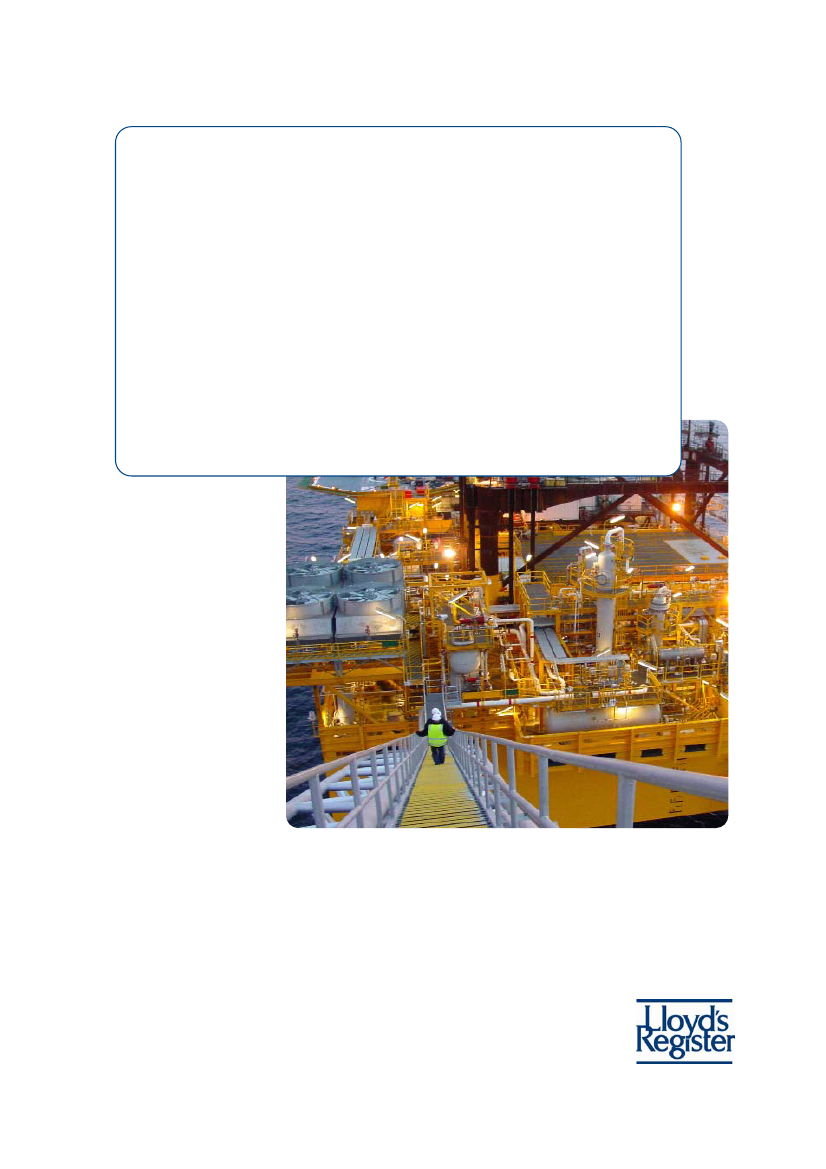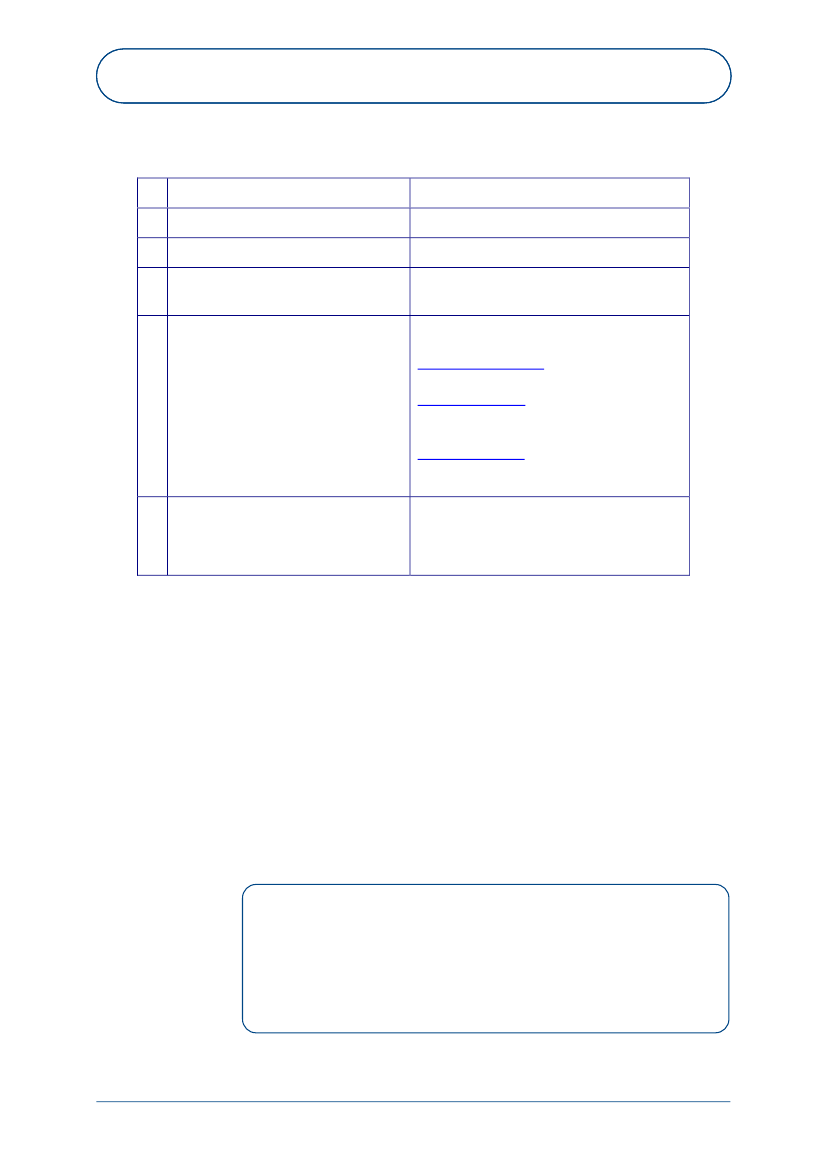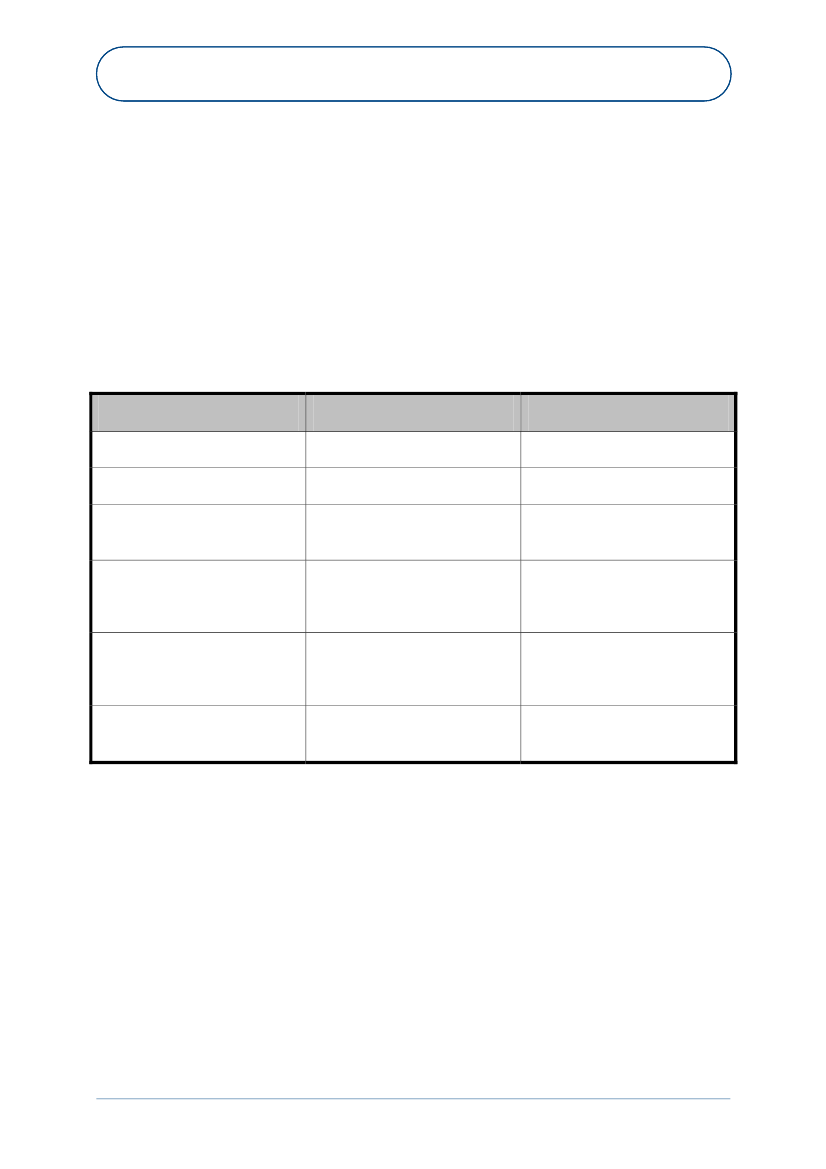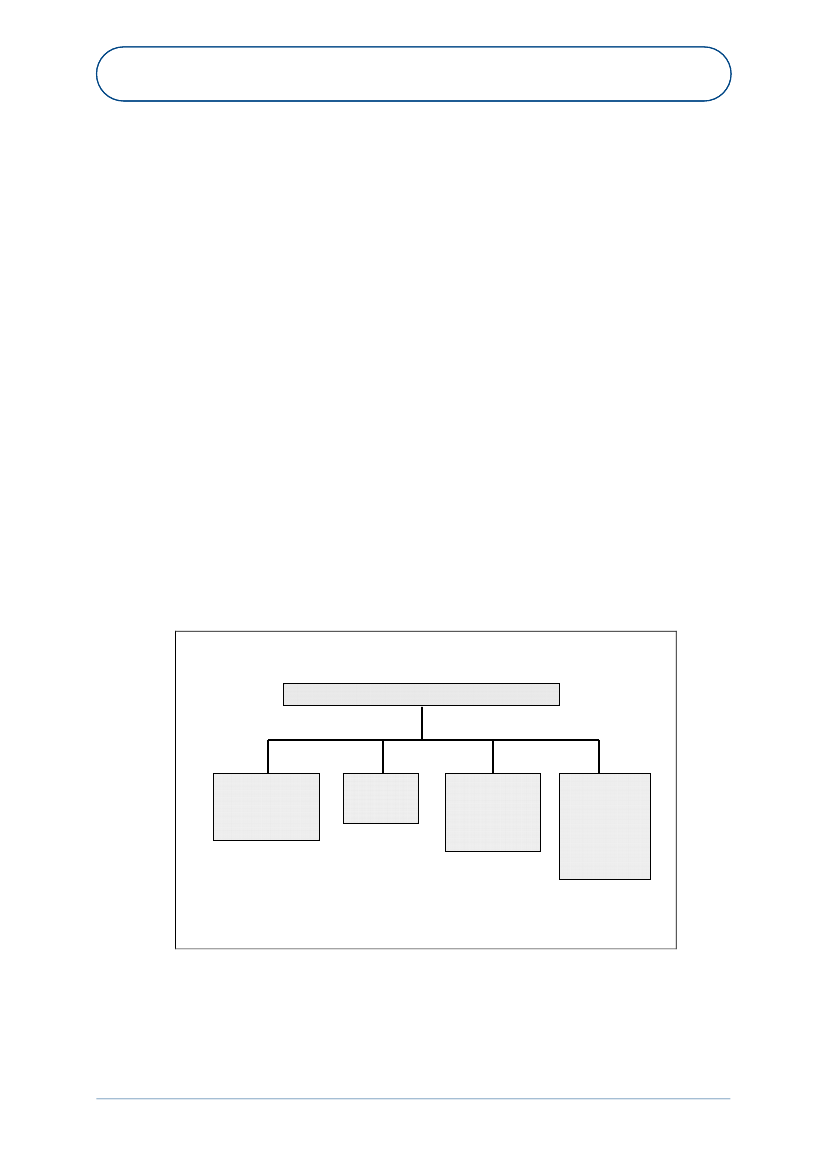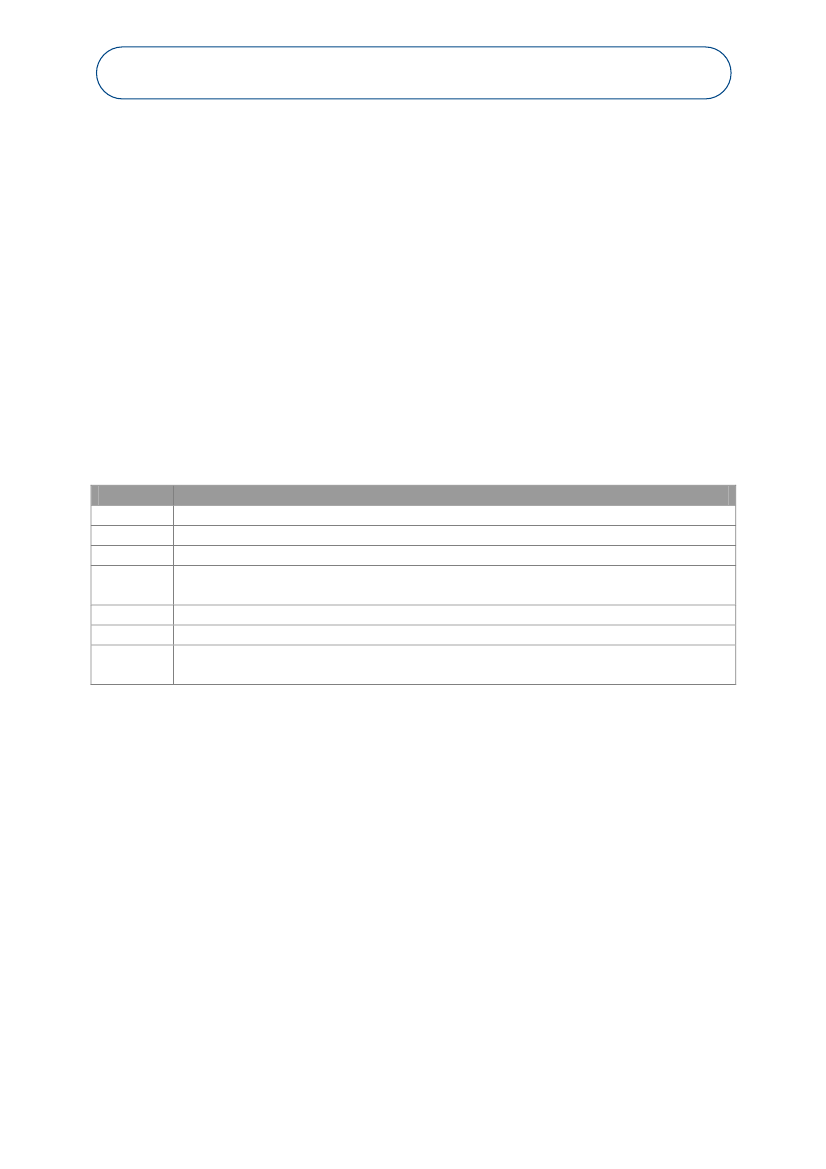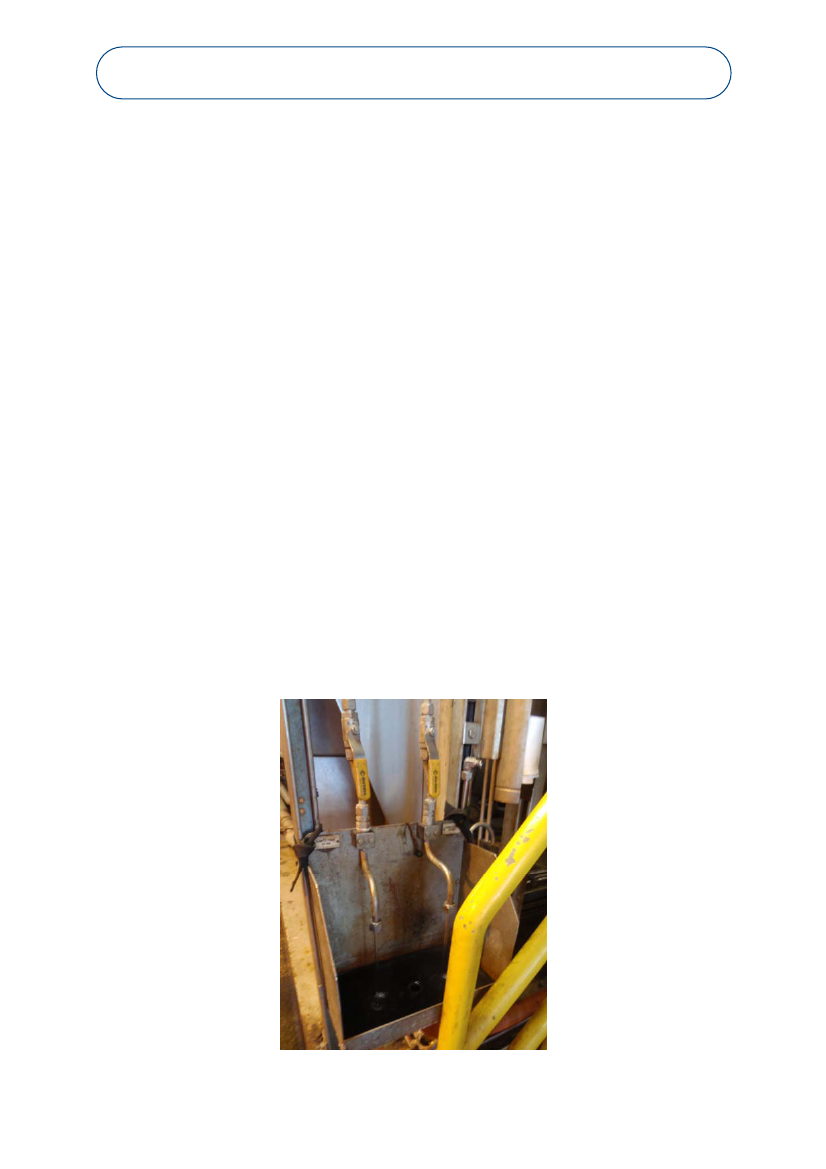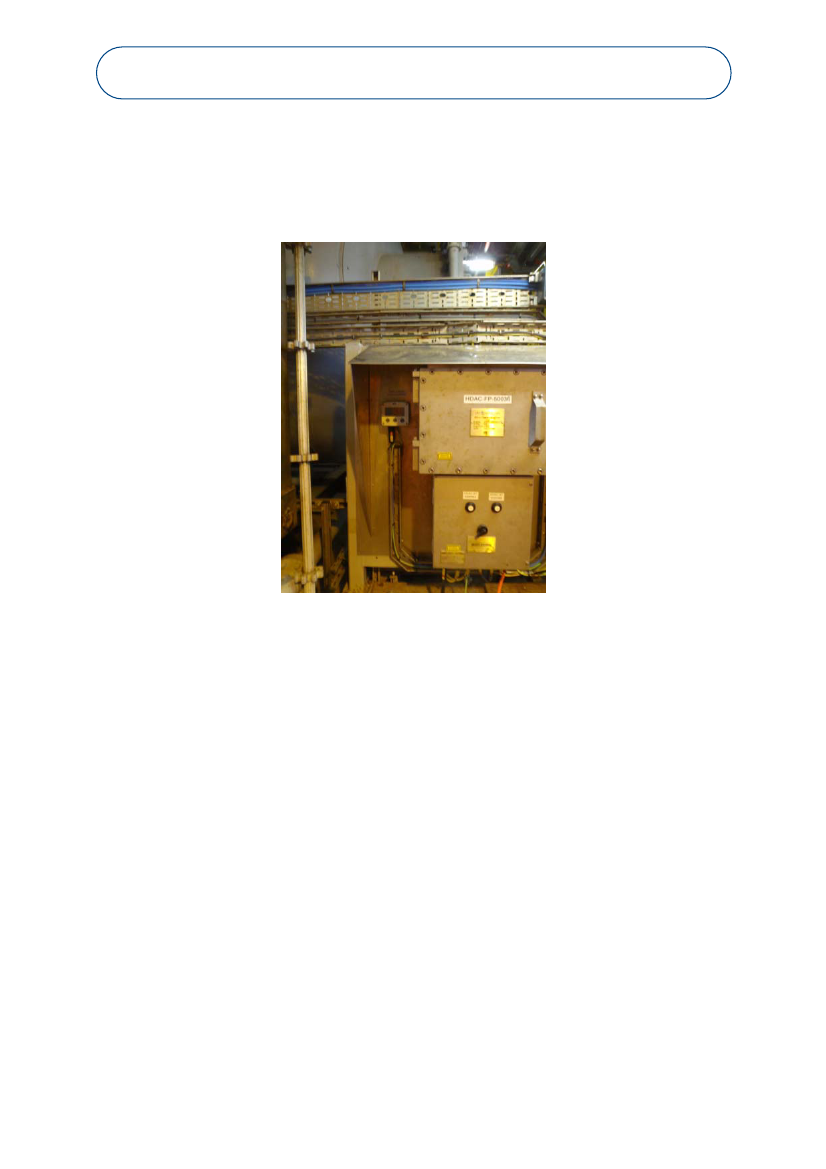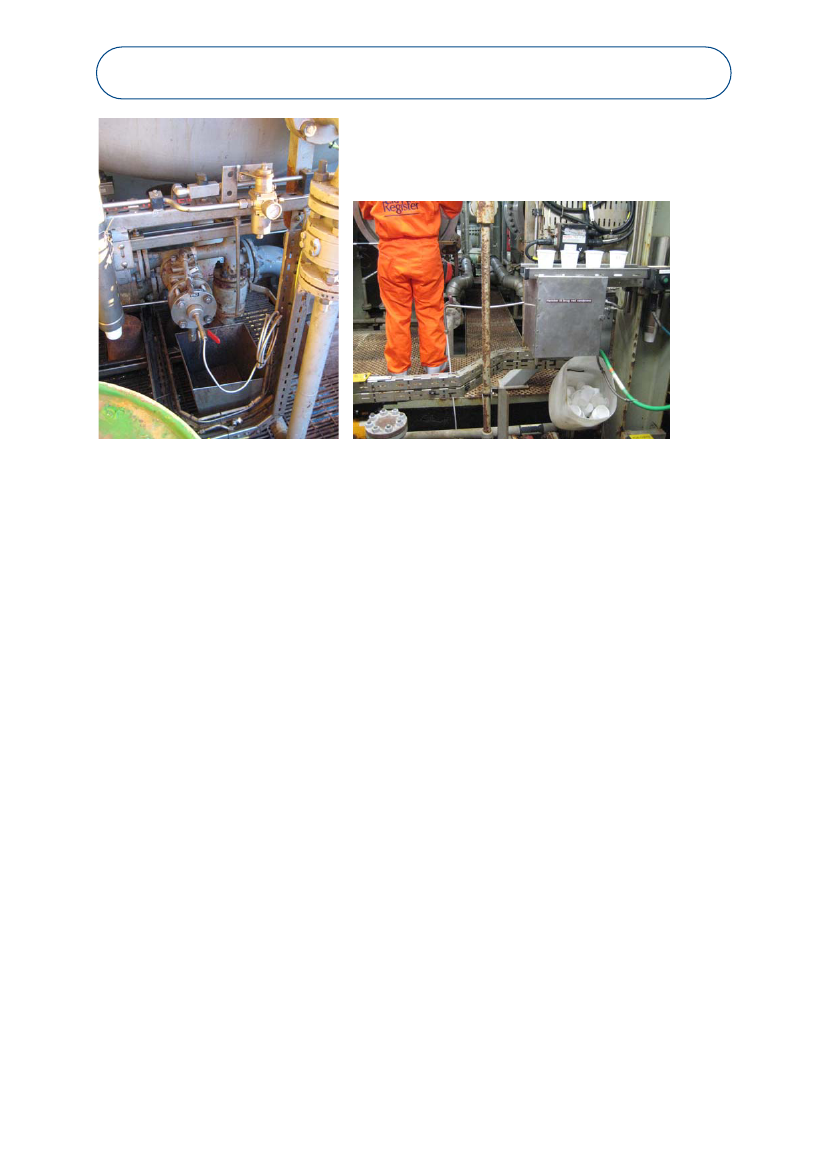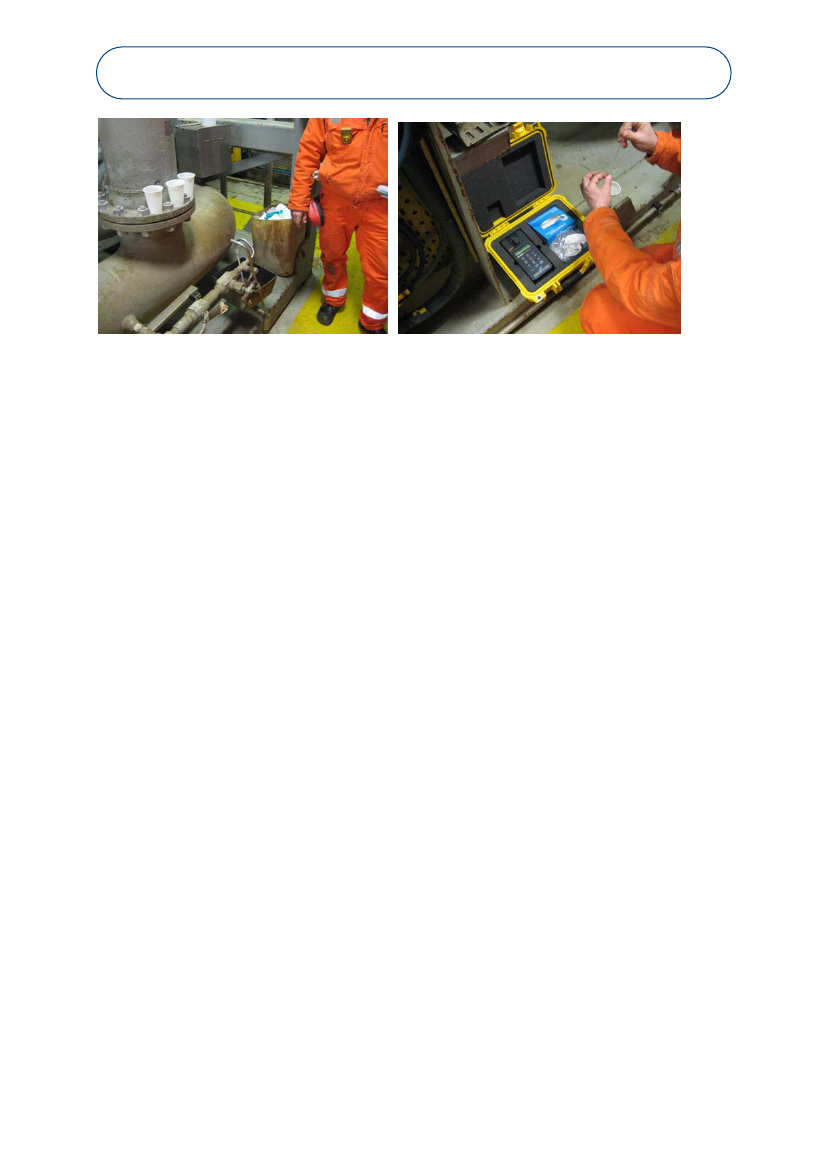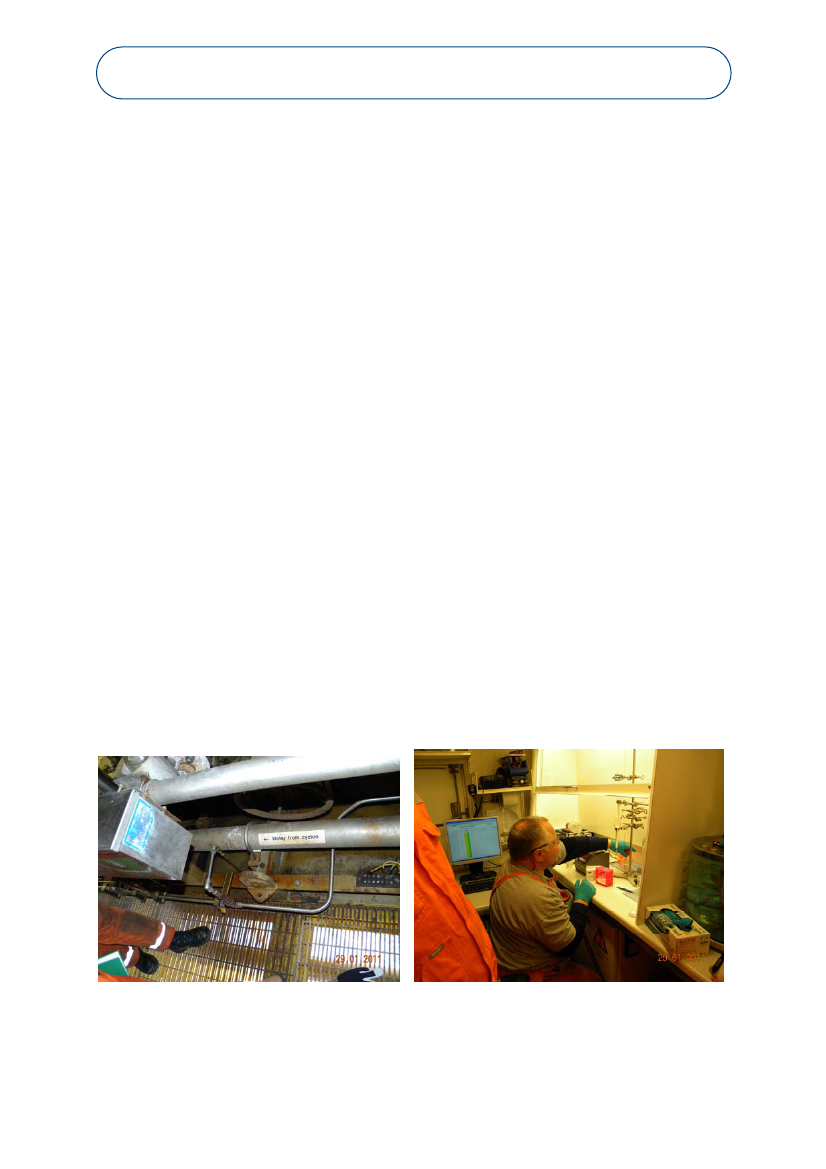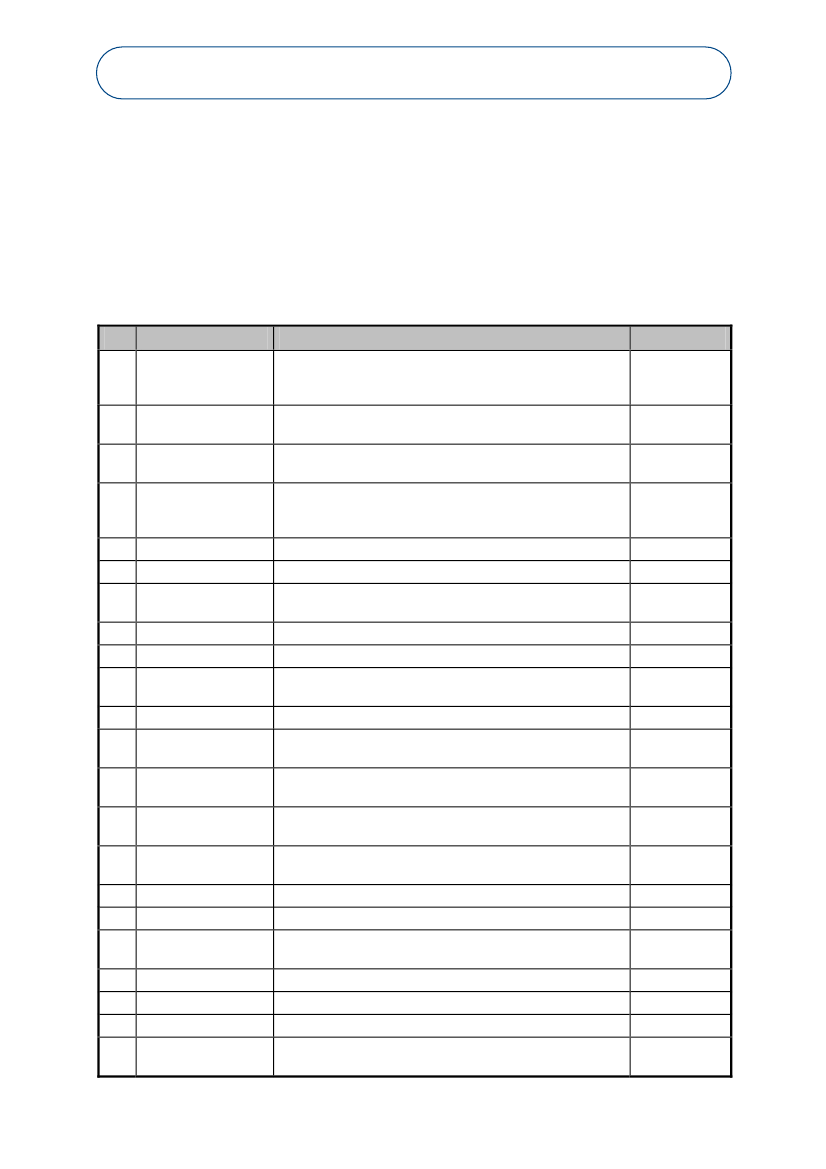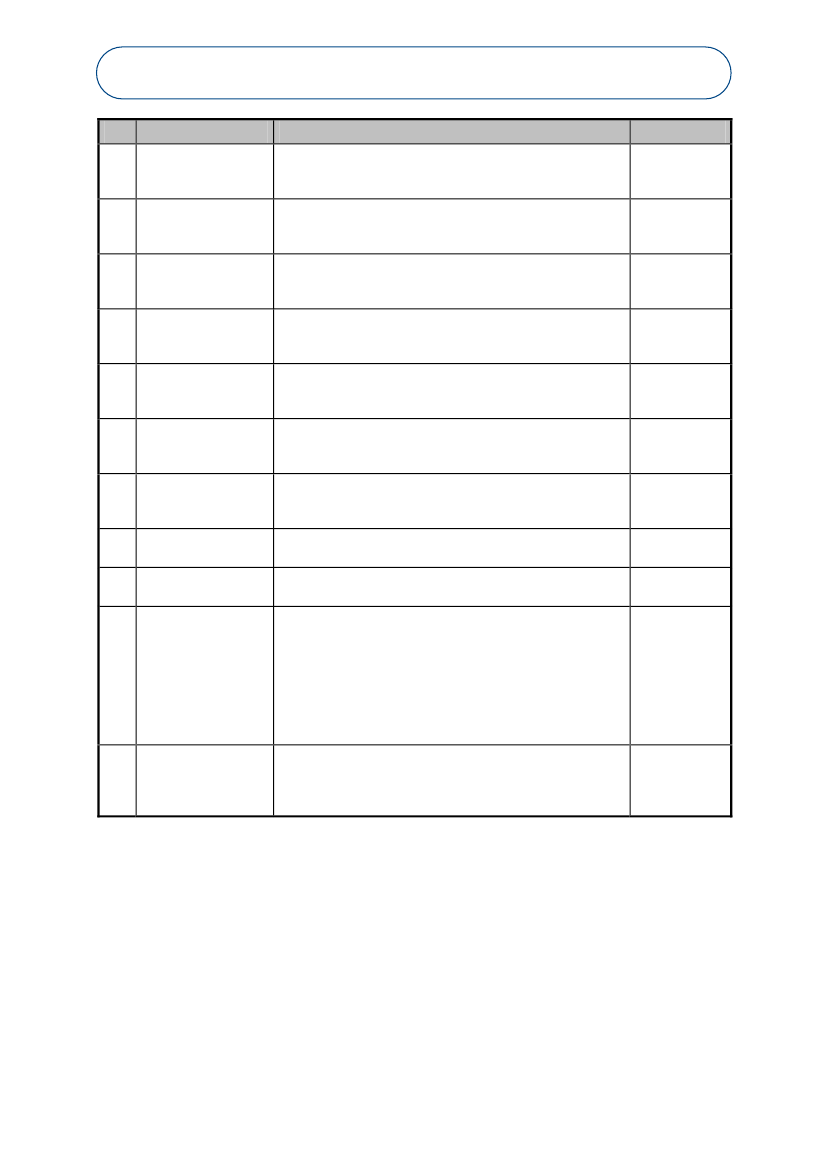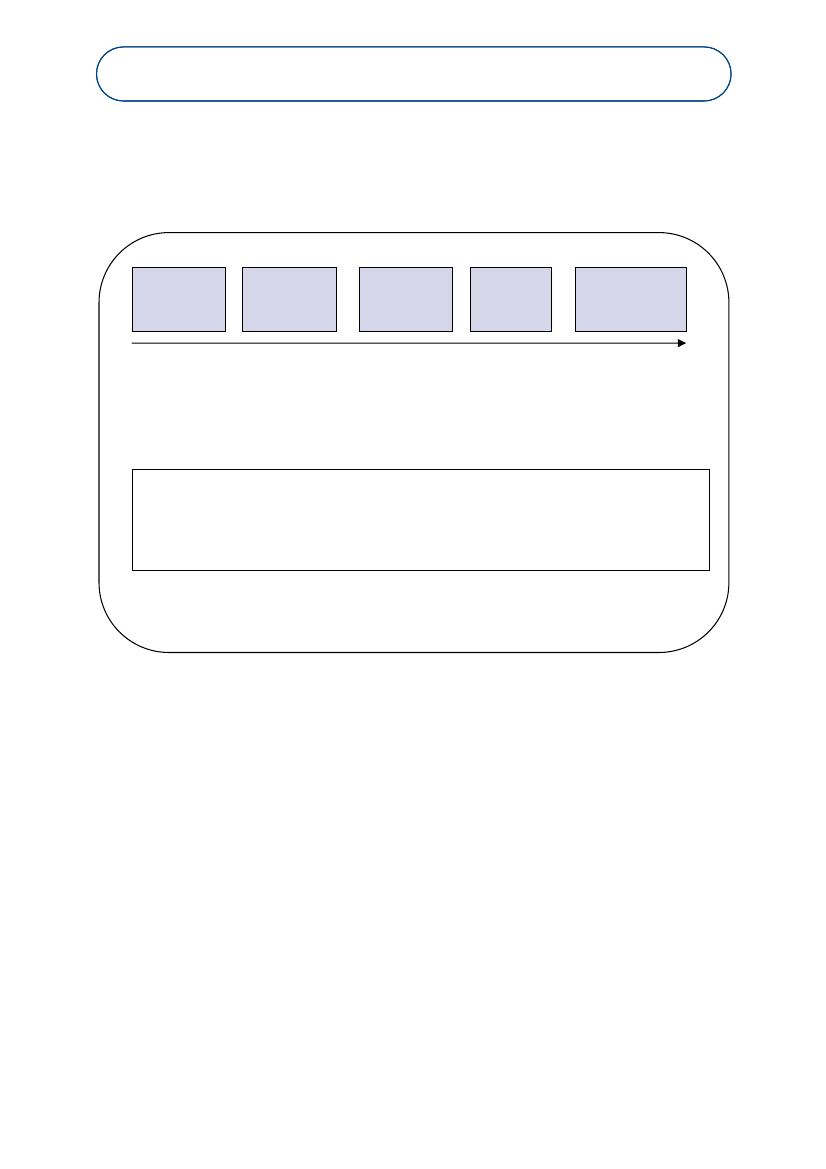Miljøudvalget 2011-12
MIU Alm.del
Offentligt
Report and Executive SummaryCritical Review of Produced Water Sampling,Analysis and Reporting Procedures: DanishOffshore OperationsMaersk Oil DenmarkOur refABN1191601/002.001
LIFE MATTERS
REPORT AND EXECUTIVE SUMMARY:CRITICAL REVIEW OF PRODUCED WATER S AMPLING,AN ALYSIS AND REPORTING PROCEDURES: DANISH OFFSHORE OPERATIONS
Contactsa)b)c)d)Registered nameRegistration numberRegistered addressAberdeen Office addressWritten by:Per Christofferson (Senior Consultant,Lloyd's Register Scandpower)Linda Murray (Consultant, ConsultingServices, Lloyd's Register EMEA)Amy Annand (Principal Consultant/TeamLeader, Consulting Services, Lloyd'sRegister EMEA)Lloyd’s Register EMEA29592R71 Fenchurch Street, London, EC3M 4BSDenburn House, 25 Union Terrace, Aberdeen,AB10 1NNMain Tel: + 44 (0)1224 267400[email protected]M +46 (0)708 690211[email protected]T+44 (0)1224 267872[email protected]M +44 (0)7770 958246T +44 (0)1224 267400F +44 (0)1224 267401M +44 (0)7768 214797
e)
f)
Approved by:Nick Jackson (Head of Consulting,Lloyd's Register EMEA)
Lloyd's Register EMEA, its affiliates and subsidiaries and their respective officers, employees oragents are, individually and collectively, referred to in this clause as the ‘Lloyd's RegisterGroup’. The Lloyd's Register Group assumes no responsibility and shall not be liable to anyperson for any loss, damage or expense caused by reliance on the information or advice in thisdocument or howsoever provided, unless that person has signed a contract with the relevantLloyd's Register Group entity for the provision of this information or advice and in that caseany responsibility or liability is exclusively on the terms and conditions set out in that contract.� Lloyd’s Register EMEA 2011
REPORT AND EXECUTIVE SUMMARY:CRITICAL REVIEW OF PRODUCED WATER S AMPLING,AN ALYSIS AND REPORTING PROCEDURES: DANISH OFFSHORE OPERATIONS
ContentsExecutive Summary1.1.12.2.12.23.3.13.23.33.43.5Introduction and Scope of WorkMethodologyKey FindingsCommendationsAreas for ImprovementRecommendationsOiW Procedural RecommendationData Integrity RecommendationsRobust Verification RecommendationsCompetency Assurance RecommendationsTyra East specific improvements2910121213171718181919
AppendicesAppendix 1.Appendix 2.Appendix 3.Appendix 4.Appendix 5.Appendix 6.Appendix 7.Appendix 8.Asset Specific Review: Tyra WestAsset Specific Review: Tyra EastAsset Specific Review: HalfdanAsset Specific Review: DanAsset Specific Review: Gorm (including Skjold)Asset Specific Review: HaraldDocumentation ReviewedPrinciples of Good Laboratory Practices
Lloyd's Register EMEA
Page 1
28/02/2011
Maersk Oil Denmark
REPORT AND EXECUTIVE SUMMARY:CRITICAL REVIEW OF PRODUCED WATER S AMPLING,AN ALYSIS AND REPORTING PROCEDURES: DANISH OFFSHORE OPERATIONS
Executive SummaryIntroductionDuring December 2010, Maersk Oil Denmark was subject to allegations published in the Danishnewspaper,Politiken, regarding the integrity of their produced water management processes,including Oil-in-Water (OiW) analysis and reporting. Maersk Oil Denmark engaged Lloyd'sRegister EMEA to conduct an independent review of the associated environmental processesand procedures (including implementation). Initial reviews of the Tyra production unit wereconducted by Nick Jackson and Amy Annand of Lloyd's Register EMEA, and Stig Stangeland ofLloyd's Register Scandpower. Subsequent reviews of the DUC operations were conducted byPer Christofferson of Lloyd's Register Scandpower and Linda Murray of Lloyd's Register EMEA;they were also supported onshore (Esbjerg) by Amy Annand and Nick Jackson.Scope of WorkLloyd's Register EMEA reviewed and determined the degree to which Maersk Oil Denmark’sproduced water sampling, analysis and reporting (i.e. specifically Oil-in-Water/OiW) processestruly reflected accepted industry practice. The review evaluated existing documented processesand procedures, and compared their implementation onshore and offshore to recognisedindustry practice, best laboratory practice, and also compliance with the current OiW dischargepermits for operating in the Danish sector of the North Sea. The review also included a series ofinterviews with workforce representatives who developed and used these processes andprocedures. Additionally, the review verified a number of samples of reported concentrations,following the path along data transfer points.The LR EMEA review teams visited:•••••••FindingsTyra West.Tyra East.Dan.Halfdan.Gorm (including Skjold).Harald.Esbjerg offices.
Commendations•Maersk Oil Denmark has established appropriate procedures (specifically OPM 2B Part 3Rev 9) and associated guidance documents and initiatives which enable operations tomeet expectations of the discharge permits associated with the Danish production units.It is noted that in response to the recent changes to the discharge permit, Maersk OilDenmark has already commenced a review and revision of the OiW procedures andpractices.
Lloyd's Register EMEA
Page 2
28/02/2011
Maersk Oil Denmark
REPORT AND EXECUTIVE SUMMARY:CRITICAL REVIEW OF PRODUCED WATER S AMPLING,AN ALYSIS AND REPORTING PROCEDURES: DANISH OFFSHORE OPERATIONS
•
Processes are established for employee engagement in procedural change (i.e. theupdated Rev 9 of the OiW procedure and Rev 10 that is a work in progress).Feedback indicated that the response and reporting culture relating to dischargeconcentrations greater than 20 mg/l appears to be supportive and reflective of goodpractice.The action level for OiW is 20 mg/l, although the permit defines average monthlydischarge limit of 30mg/l. This means that corrective action is often applied before apermit breach occurs. It is also noted that Maersk Oil Denmark has stipulated variousinternal KPIs, some as low as 5 mg/l for specified discharge points.As part of their continual improvement processes, Maersk Oil Denmark hasimplemented a number of initiatives to improve the efficiency of produced watertreatment on board. These have included increasing heating capacity in order toimprove separation efficiency, improving flow and skimming properties of the de-gasser,relocating the injection points for the water clarifier, and reducing flow throughputfluctuations.Evidence indicated that further improvements to the produced water treatmentprocesses will be introduced. These include exploring the use of online OiW monitoringand investigating the accuracy of overboard flow metering systems.Daily production checks are conducted on individual produced water process trains.These checks include levels, pressures and temperatures of specific treatmentequipment and processes. This data is then used to troubleshoot and define correctiveactions if the 20 mg/l limit is exceeded. Some platforms have also implemented in-linecontinuous OiW monitoring processes to enhance process control and troubleshooting.Evidence obtained from offshore conversations confirmed that employees (e.g. the CCR)are empowered to shut down wells/operations and have done so when necessary.Communication with regard to OiW appears to be open and honest, and the workforceis actively encouraged to report on any observed undesired emissions and processdeviations. The "eyes and ears" of the workforce were seen to be an important tool inmonitoring OiW treatment.It is clear that some sound practices have been established and individuals know how torespond and troubleshoot when OiW KPIs are exceeded.It is clear that the overwhelming majority of the workforce has great pride in workingfor Maersk Oil Denmark and cares deeply about their responsibilities. People reportedthat they did not understand what prompted the newspaper allegations, which theybelieved did not represent the Maersk Oil organisation that they work for, or the realityof OiW management.
•
•
•
•
•
•
•
•
•
Lloyd's Register EMEA
Page 3
28/02/2011
Maersk Oil Denmark
REPORT AND EXECUTIVE SUMMARY:CRITICAL REVIEW OF PRODUCED WATER S AMPLING,AN ALYSIS AND REPORTING PROCEDURES: DANISH OFFSHORE OPERATIONS
Areas for ImprovementThe critical OiW review identified six areas of potential improvement, which are summarisedbelow.
OiW procedureThe OiW Sampling, Analysis and Reporting procedure (OPM 2B, Part 3, Rev 9) enablesoperations to meet the expectations of the discharge permits. However, the clarity andstructure of the procedure can be strengthened. Visibility and understanding of the overall OiWsample collection, analysis and reporting process within the procedure could be improvedthrough the use of Process Mapping.It is noted that the OiW procedure differs slightly from the reference (OSPAR) method, withexamples highlighted below:•••••Sample and reagent volumes.Sample gas release.Sample clean-up.Emulsification of sample.Blank samples.
The review of the OiW procedure also identified an inconsistent approach to the level of detailcontained within the asset specific sections of the procedure. There should be a standardisedminimum amount of platform specific data included in all asset specific sections of theprocedure. Additionally, there is a lack of platform specific information relating to (whereapplicable):••Expectations relating to communication, and how knowledge or data is transferred.Details related to the use of in-line and/or continuous monitoring equipment tosupplement OiW management.Sampling (including when samples should and should not be taken), labelling,packaging, protection, storage and transporting (i.e. sample custody and integrity).Determining total volume of re-injected produced water and total volume of overboardproduced water.Post analysis reporting (i.e. cross-referencing workbooks, production logs and OiWdatabase).
•
•
•
Integrity of dataThe Lloyd's Register EMEA reviews could find no evidence that the OiW data had been falsified.However, the lack of robust and transparent sample and data management means that MaerskOil Denmark is exposed to the potential for error and misconduct. Identified examples of theseexposures include the following:
Lloyd's Register EMEA
Page 4
28/02/2011
Maersk Oil Denmark
REPORT AND EXECUTIVE SUMMARY:CRITICAL REVIEW OF PRODUCED WATER S AMPLING,AN ALYSIS AND REPORTING PROCEDURES: DANISH OFFSHORE OPERATIONS
•••••••
Existing sample custody practices introduce the potential for samples to be tamperedwith or to be misplaced; however, there was no evidence that this had taken place.Critical data is sometimes verbally transferred.There is a lack of written Laboratory Logbooks (denoting sample times, analyticalresults, anomalies, changes, errors, comments etc.).There is a lack of security of data contained within platform specific Excel workbooks.When changes are made to data contained within the workbook, there is no record ofthe original data or documented reason for the change.Sense checks (conducted onshore) of reported concentrations did not consistentlycapture noted data anomalies.The first point of verification (using existing practices) is the Excel spreadsheetworkbook. This is an issue because the spreadsheet is populated at an advanced stageof the OiW sampling, analytical and reporting process.
Lack of robust verificationThe overall process for OiW management should be underpinned by robust verification andQuality Assurance. The review revealed a number of areas where Maersk Oil Denmark did notdemonstrate structured processes to assure data quality and compliance with best practice.Examples of these areas include:•••••Lack of structured supervisory Quality Assurance.Lack of robust verification of On-the-Job training.No QC samples analysed to provide assurance of accuracy of results. NB: this is notaligned with good laboratory practice.Lack of robust internal audits in order to scrutinise OiW processes.The limit of the scope of the Force Technology Audits (i.e. only sampling andlaboratory practices and OSPAR correlation) did not enable complete verification ofOiW processes.
Degree of variability of reported concentrationsThe uncertainty (standard deviation) of reported concentrations and overboard oil volumes isnot fully quantified. Variability levels will be associated with:•The sensitivity of Wilkes Analyzer at lower concentrations (NB: Maersk Oil Denmark hasdetermined the Limit of Detection to be approximately 4mg/l).Page 528/02/2011Maersk Oil Denmark
Lloyd's Register EMEA
REPORT AND EXECUTIVE SUMMARY:CRITICAL REVIEW OF PRODUCED WATER S AMPLING,AN ALYSIS AND REPORTING PROCEDURES: DANISH OFFSHORE OPERATIONS
••••
Individual pieces of laboratory equipment (e.g. balances, volumetric flasks, measuringcylinders etc.).Differing approaches by individuals with regard to sample collection, storage,extraction and clean-up.The OSPAR correlation method.Accuracy of overboard flow meters.
The cumulative variability with the aforementioned elements creates an unknown level ofuncertainty for the method. Understanding the lower limits of detection is particularlyimportant for reporting lower concentrations, especially those concentrations related to OiWKPIs.
Competency assurance processesMaersk Oil Denmark is currently establishing a structure for offshore workforce trainingprogrammes which includes: training needs analysis, job descriptions, technical trainingprogrammes, On-the-Job training programmes etc. This is documented and managed onshorevia the Learning Management System (LMS). This framework is still under development andtherefore is not fully implemented.The offshore workforce’s individual training programmes are documented in the LMS. It is theexpectation that employees will be trained by experienced team members based on tailored rolespecific training programmes.
Tyra East specific improvementsSome participants on board Tyra East described strong feelings of mistrust towardsmanagement both on and offshore. This was supported by perceptions of exclusion and lack ofinvolvement, which are further compounded by stated beliefs that communications betweenoffshore and onshore are ineffective.Conclusions and Recommendations
OiW procedureIn line with our findings, the OiW procedure (OPM 2B, Part 3, Rev 9) requires a significantupdate to meet the requirements of the new discharge permit. This upgrade should alsoaddress the expectations of OSPAR and strengthen the clarity and structure of the procedure.The platform specific information (e.g. platforms without laboratory facilities, platforms that re-inject produced water etc.) should also undergo a critical review to ensure adequacy. This willenable consistent understanding and application of the overall OiW sample collection, analysisand reporting process.
Integrity of data
Lloyd's Register EMEA
Page 6
28/02/2011
Maersk Oil Denmark
REPORT AND EXECUTIVE SUMMARY:CRITICAL REVIEW OF PRODUCED WATER S AMPLING,AN ALYSIS AND REPORTING PROCEDURES: DANISH OFFSHORE OPERATIONS
The findings indicate that there is a lack of robust and transparent sample and datamanagement meaning that Maersk Oil Denmark is exposed to the potential for error andmisconduct. It is therefore recommended that Maersk Oil Denmark implements a number ofdata integrity control measures in order to reduce the risks associated with inaccurate OiWreporting. These measures include:••••••The platform specific instructions should be developed to include a documentedsampling plan and procedure.Formally document and log verbal transfer of critical information.Establish ‘Good Laboratory Practice’ with the use of written Laboratory Logbooks.Introduce data security controls within platform specific workbooks.Formalise onshore based sense checks to capture noted data anomalies.Introduce robust verification processes that would verify the data trail from samplecollection to reporting.
Lack of robust verificationThe overall process for OiW management should be underpinned by robust verification andQuality Assurance. The review revealed a number of areas where Maersk Oil Denmark did notdemonstrate structured processes to assure data quality and compliance with best practice.These processes should include:••••••Structured supervisory Quality Assurance.Robust verification of On-the-Job training.Analyse QC samples to provide assurance of accuracy of results.Robust internal audits.Third party audits.Update procedures: ensure that the verification processes add value, and are alignedwith revised OiW procedures.
Degree of variability of reported concentrationsInevitably sample collection, custody, analysis and reporting processes will introduce somedegree of variability in reported OiW concentrations. The Limit of Detection is likely to beimportant when the data is utilised for the setting and achieving of internal KPIs, where theseare at levels lower than those that can be reasonably detected. It is therefore recommendedMaersk Oil Denmark attempts to quantify the lower Limit of Detection for the OiW method andrecognises it when setting internal OiW KPIs.
Competency assurance processesMaersk Oil Denmark is currently establishing a structure for offshore workforce trainingprogrammes. They must formalise arrangements to ensure that:
Lloyd's Register EMEA
Page 7
28/02/2011
Maersk Oil Denmark
REPORT AND EXECUTIVE SUMMARY:CRITICAL REVIEW OF PRODUCED WATER S AMPLING,AN ALYSIS AND REPORTING PROCEDURES: DANISH OFFSHORE OPERATIONS
•
Existing and new Laboratory Technicians should either complete the newly developedOiW training programme, or verify competency levels of existing Laboratory Techniciansagainst the programme requirements.All relevant job descriptions are cohesive and complete. They must accurately reflectproduced water management tasks and responsibilities.Training programmes are implemented as per identified needs.On-the-Job training is formalised, including verification.
•••
Tyra East specific improvementsCritical review findings relating to the Tyra East installation differ from the other DUC assets.Specific recommendations pertaining to this asset are:•Maersk Oil Denmark has processes to enable individuals to report concerns. It isimportant that these processes are not only established, but are fully supported andpeople are encouraged to use them. While recognising that this process is supportedby Maersk Oil Denmark, it is clear that some individuals on Tyra East elected to choosea different vehicle to communicate concerns. In support of this recommendation, aculture of openness in reporting and communicating should be further nurtured andembraced within the organisation.Maersk Oil Denmark should carefully consider the internal communication andmanagement actions to be taken in the aftermath of these events. This would includecommunication (i.e. internal/external announcements, lessons learned, and individualresponse actions) to the workforce and relevant stakeholders. This should clearly definethe expectations of onshore and offshore management, and those actively involved inthe OiW processes.
•
Lloyd's Register EMEA
Page 8
28/02/2011
Maersk Oil Denmark
REPORT AND EXECUTIVE SUMMARY:CRITICAL REVIEW OF PRODUCED WATER S AMPLING,AN ALYSIS AND REPORTING PROCEDURES: DANISH OFFSHORE OPERATIONS
1.
Introduction and Scope of WorkDuring December 2010, a series of newspaper allegations raised a number of significantconcerns within the Maersk Oil operations in Denmark. As a result, Lloyd's Register EMEA wasengaged to conduct a critical review of procedures relating to produced water management.These reviews were carried out via a series of onshore and offshore visits between lateDecember 2010 and February 2011.The scope of that review examined the adequacy and suitability of the existing Maersk OilDenmark procedures for sampling, analysis, and reporting of overboard produced waterdischarges on board DUC installations, including:••••••Tyra West.Tyra East.Dan.Halfdan.Gorm (including Skjold).Harald.
The review also conducted some verification of the procedures as implemented both on andoffshore, and commented on the effectiveness of the procedures and how they are applied.Specific elements of the review included:•A detailed review of the procedures employed for sampling, analysis, and reporting ofoverboard produced water discharges.An independent comparison of the procedures when compared to recognised industrypractice (e.g. UK Department of Energy and Climate Change Guidance Notes for theSampling and Analysis of Produced Water and other Hydrocarbon Discharges).The identification of any omissions or inaccuracies within the procedures.The review of associated documentation i.e. calibration procedures and certification,historical analytical results, Laboratory Technicians' sampling and analysis notes,competency assurance documentation, maintenance records, audit reports, dischargepermits, job descriptions, production logs etc.Independent verification of the implementation of the procedures both on and offshore;this would include comment on the effectiveness of the procedures and how they areapplied.A number of samples of reported concentrations were verified, following the pathalong data transfer points: from sample collection to analysis to concentrationcalculations to reported figures.Detailed reporting of the Lloyd’s Register EMEA findings and recommendations,including the chain of consistency and integrity relating to the Maersk Oil Denmarkprocedures.
•
••
•
•
•
Lloyd's Register EMEA
Page 9
28/02/2011
Maersk Oil Denmark
REPORT AND EXECUTIVE SUMMARY:CRITICAL REVIEW OF PRODUCED WATER S AMPLING,AN ALYSIS AND REPORTING PROCEDURES: DANISH OFFSHORE OPERATIONS
The scope of work for the Tyra East asset varied slightly in focus from the other assets, in that itincluded an investigative process into the circumstances leading to the publication of thenewspaper articles, and detailed discussions with individuals connected with the allegations, aswell as the OiW review. As a result, the review that was conducted on board Tyra East hadmore emphasis relating to the newspaper allegations and did not go into the depth ofverification and sampling of the produced water procedure and processes. There was, however,an onshore based review of Tyra East data and reported figures.It is noted that at the conclusion of the review, new discharge permit requirements were issuedby the Danish Environmental Protection Authority. These new requirements dictate thatMaersk Oil Denmark will need to revise their oil in water sampling and analysis procedures andassociated practices. Although the scope for this review did not explicitly include anassessment of Maersk Oil Denmark's ability to meet these more stringent permitry requirements,we have included some commentary relating to the new permit requirements in the body ofthis report. Maersk Oil Denmark have committed to conduct a further OiW review in 6-8months time to ensure that new discharge requirements have been embedded and that therevised procedure is effective and adhered to.
1.1
MethodologyThe critical review process included:•••••Review of relevant documentation provided to Lloyd's Register EMEA by Maersk OilDenmark.A series of interviews with relevant personnel on the chosen installations, as wellrelevant beach based personnel with involvement in produced water management.Observations of laboratories and laboratory equipment.Observations of water sampling, sample custody and transport, analysis and reportingprocedures being performed onsite.Visiting and study of water treatment process equipment and sampling points.
Each report from individual installations identifies personnel that were interviewed as part of theonsite reviews. Interviews were also conducted with onshore team members who haveproduced water management responsibilities. These people included:•••••••Steffen Fredberg Hansen – Chemistry & Environment Department.Joan Jacobsen – Training Coordinator.Lars Hvejsel Hansen – Head of Chemistry & Environment Department.Hans Henrik Kristensen – Head of Production Operations.Britt Gydesen – Chemistry & Environment Department.Jette J Østergaard – Chemistry & Environment Department.Ole Andersen – Metering Department.
A number of documents were reviewed and are listed in Appendix 7. These documents relateto various aspects of produced water management, including procedures, organisational charts,discharge permits, analytical results contained in spreadsheets, training programmes, jobdescriptions etc. There were also several other documents that were reviewed onsite. TheLloyd's Register EMEAPage 1028/02/2011Maersk Oil Denmark
REPORT AND EXECUTIVE SUMMARY:CRITICAL REVIEW OF PRODUCED WATER S AMPLING,AN ALYSIS AND REPORTING PROCEDURES: DANISH OFFSHORE OPERATIONS
documents were used as input and planning of the review and the content was followed up byinterviews and observations.
Lloyd's Register EMEA
Page 11
28/02/2011
Maersk Oil Denmark
REPORT AND EXECUTIVE SUMMARY:CRITICAL REVIEW OF PRODUCED WATER S AMPLING,AN ALYSIS AND REPORTING PROCEDURES: DANISH OFFSHORE OPERATIONS
2.2.1
Key FindingsCommendations•Maersk Oil Denmark has established appropriate procedures (specifically OPM 2BPart 3 Rev 9) and associated guidance documents and initiatives which enableoperations to meet expectations of the discharge permits associated with the Danishproduction units. It is noted that in response to the recent changes to the dischargepermit Maersk Oil Denmark has already commenced a review and revision of the OiWprocedures and practices.Processes are established for employee engagement in procedural change (i.e. theupdated Rev 9 of the OiW procedure and Revision 10 that is work in progress).Feedback indicated that the response and reporting culture relating to dischargeconcentrations greater than 20 mg/l appears to be supportive and reflective of goodpractice.The action level for OiW is 20 mg/l, although the permit defines average monthlydischarge limit of 30mg/l. This means that corrective action is often applied before apermit breach occurs. It is also noted that Maersk Oil Denmark has stipulated variousinternal KPI s, some as low as 5 mg/l for specified discharge points.As part of their continual improvement processes, Maersk Oil Denmark hasimplemented a number of initiatives to improve the efficiency of produced watertreatment on board. These have included increasing heating capacity to in order toimprove separation efficiency, improving flow and skimming properties of the de-gasser, relocating the injection points for the water clarifier, and reducing flowthroughput fluctuations.Evidence indicated that further improvements to the produced water treatmentprocesses will be introduced. These include: exploring the use of online OiWmonitoring and investigating the accuracy of overboard flow metering systems.Daily production checks are conducted on individual produced water process trains.These checks include: levels, pressures and temperatures of specific treatmentequipment and processes. This data is then used to troubleshoot and define correctiveactions if the 20 mg/l limit is exceeded. Some platforms have also implemented in-linecontinuous OiW monitoring processes to enhance process control and troubleshooting.Evidence obtained from offshore conversations confirmed that employees (e.g. theCCR) are empowered to shut down wells/operations and has done so when necessaryon some occasions.Communication with regard to OiW appears to be open and honest, and theworkforce is actively encouraged to report on any observed undesired emissions andprocess deviations. The ‘eyes and ears’ of the workforce were seen to be an importanttool in monitoring OiW treatment.It is clear that some sound practices have been established and individuals know howto respond and troubleshoot when OiW KPIs are exceeded.It is clear that the overwhelming majority of the workforce has great pride in workingfor Maersk Oil Denmark and care deeply about their responsibilities. People reportedthat they did not understand what prompted the newspaper allegations, which theybelieved did not represent the Maersk Oil organisation that they work for, or the realityof OiW management.
••
•
•
•
•
•
•
••
Lloyd's Register EMEA
Page 12
28/02/2011
Maersk Oil Denmark
REPORT AND EXECUTIVE SUMMARY:CRITICAL REVIEW OF PRODUCED WATER S AMPLING,AN ALYSIS AND REPORTING PROCEDURES: DANISH OFFSHORE OPERATIONS
2.2
Areas for ImprovementA number of emerging themes or issues were identified during the review, as identified below.
2.2.1
OiW ProcedureThe OiW Sampling, Analysis and Reporting procedure (OPM 2B, Part 3, Rev 9) enablesoperations to meet the expectations of the discharge permits. However, the clarity andstructure of the procedure can be strengthened. Visibility and understanding of the overallOiW sample collection, analysis and reporting process within the procedure could be improvedthrough the use of Process Mapping.It is noted that the OiW procedure differs slightly from the reference (OSPAR) method, withexamples highlighted below:IssueOiW Procedure500ml bottle for 400ml sample.25ml n-pentane.Shake the sample bottle torelease gasses.Use non-activated florisil.No use of sodium sulfate.OSPAR reference method1 litre bottle, 90% full.50ml n-pentane.Cap the sample, release cap,allow it to cool, and re-tighten.Use activated florisil.Use of sodium sulfate.Use of centrifuge.Addition of magnesium sulfate.
Sample volume.Reagents.Sample gas release.
Sample clean-up.
Emulsification of sample.
No guidance.
Blank samples.
No guidance.
Blank tests should be carried outwith each series of tests.
There is a potential for these deviations have the potential to introduce a degree of error intothe method (e.g. sample clean up may not be as effective when using non-activated Florisil,resulting in potentially higher results). Additionally, shaking the sample could potentiallyrelease VOCs, with a resultant reduction in OiW concentrations and errors in reported data.The review of the OiW procedure also identified an inconsistent approach to the level of detailcontained within the asset specific sections of the procedure. There should be a standardisedminimum amount of platform specific data included in all asset specific sections of theprocedure. Additionally, there is a lack of platform specific information relating to (whereapplicable):••Expectations relating to communication, and how knowledge or data is transferred.Details related to the use of in-line and/or continuous monitoring equipment tosupplement OiW management.Page 1328/02/2011Maersk Oil Denmark
Lloyd's Register EMEA
REPORT AND EXECUTIVE SUMMARY:CRITICAL REVIEW OF PRODUCED WATER S AMPLING,AN ALYSIS AND REPORTING PROCEDURES: DANISH OFFSHORE OPERATIONS
•••
Sampling (including when samples should and should not be taken), labelling,packaging, protection, storage and transporting (i.e. sample custody and integrity).Determining total volume of re-injected produced water and total volume of overboardproduced water.Post analysis reporting (i.e. cross-referencing workbooks, production logs and OiWdatabase).
Note: the procedure at the time of the review was not aligned with the new discharge permitrequirements (in particular relating to extra sampling, verification and according to theprinciples of ‘good lab practice’). Maersk Oil Denmark is currently revising the procedure tomeet the expectations of the new permit. This process should also incorporate the principles of'good lab practice'. Lloyd's Register EMEA has included a summary of ‘good lab practice’ asAppendix 8 of this document.This procedural revision reinforces the feedback received from the offshore visit where peoplerecognised the need for an overhaul of the documented processes. Some felt that minorchanges are frequently implemented, creating a collection of instructions, rather than acohesive procedure.2.2.2Integrity of DataThePolitikennewspaper allegations questioned the accuracy and integrity of the data used toreport OiW concentrations. The Lloyd's Register EMEA reviews could find no evidence thatdata had been falsified. However, a lack of robust and transparent sample and datamanagement means that Maersk Oil Denmark is exposed to the potential for error andmisconduct. Examples of these exposures include the following:•••Existing sample custody practices introduce the potential for samples to be tamperedwith or to be misplaced; however, there was no evidence that this had taken place.Critical data is sometimes transferred verbally, in particular OiW concentrations for theHalfdan and the Harald.There is a lack of written Laboratory Logbooks (denoting sample times, analyticalresults, anomalies, changes, errors, comments etc.). NB: the absence of logbooks doesnot reflect good laboratory practice.There is a lack of security of data contained within the workbook, which has openaccess to all Laboratory Technicians and the Chemistry & Environment Department.When changes are made to data contained within the workbook, there is no record ofthe original data or documented reason for the change.Sense-checks (conducted onshore) of reported concentrations did not consistentlycapture noted data anomalies.The first point of verification (using existing practices) is the Excel spreadsheetworkbook. This is an issue because the spreadsheet is populated at an advanced stageof the OiW sampling, analytical and reporting process. This leaves a lack ofopportunity to verify any of the data that is associated with the early stages of theprocess. Also see the findings associated with lack of robust verification below.
••••
Lloyd's Register EMEA
Page 14
28/02/2011
Maersk Oil Denmark
REPORT AND EXECUTIVE SUMMARY:CRITICAL REVIEW OF PRODUCED WATER S AMPLING,AN ALYSIS AND REPORTING PROCEDURES: DANISH OFFSHORE OPERATIONS
2.2.3
Lack of Robust VerificationThe overall process for OiW management should be underpinned by robust verification andQuality Assurance. The review revealed a number of areas where Maersk Oil Denmark did notdemonstrate structured processes to assure data quality and compliance with best practice.Examples of these areas include:•••••Lack of structured supervisory Quality Assurance.Lack of robust verification of On-the-Job training.No QC samples analysed to provide assurance of accuracy of results. NB: this is notaligned with good laboratory practice.Lack of robust internal audits in order to scrutinise OiW processes.The limit of the scope of the Force Technology Audits (i.e. only sampling andlaboratory practices and OSPAR correlation) did not enable complete verification ofOiW processes.
In order to ensure that the verification processes add value, they must be aligned with revisedOiW procedures and processes (once they are reflective of discharge permit requirements).2.2.4Degree of Variability of Reported ConcentrationsThe uncertainty (standard deviation) of reported concentrations and overboard oil volumes isnot fully quantified. Variability levels will be associated with:•The sensitivity of Wilkes Analyzer at lower concentrations (NB: with an extraction ratioof 1:20 as used in the OiW method, the Wilks Infracal analyser HATR T/T2 has anapproximate Limit of Detection of 4mg/l).Individual pieces of laboratory equipment (e.g. balances, volumetric flasks, measuringcylinders etc.).Differing approaches by individuals with regard to sample collection, storage,extraction and clean up.The OSPAR correlation method.Accuracy of overboard flow meters.
••••
The cumulative variability with the aforementioned elements creates an unknown level ofuncertainty for the method. Understanding the lower limits of detection is particularlyimportant for reporting lower concentrations, especially those concentrations related to OiWKPIs.2.2.5Competency Assurance ProcessesMaersk Oil Denmark is currently establishing a structure for offshore workforce trainingprogrammes which includes: training needs analysis, job descriptions, technical trainingprogrammes, On-the-Job training programmes etc. This is documented and managed onshorevia the Learning Management System (LMS). This framework is still under development andtherefore is not fully implemented.
Lloyd's Register EMEA
Page 15
28/02/2011
Maersk Oil Denmark
REPORT AND EXECUTIVE SUMMARY:CRITICAL REVIEW OF PRODUCED WATER S AMPLING,AN ALYSIS AND REPORTING PROCEDURES: DANISH OFFSHORE OPERATIONS
The offshore workforce’s individual training programmes are documented in the LMS. It is theexpectation that employees will be trained by experienced team members based on tailoredrole specific training programmes.The review also identified the following competency assurance issues related to produced watermanagement:•A training programme for Laboratory Technicians has been developed (dated 28-06-2010) reflecting laboratory requirements. All existing Laboratory Technicians weretrained well before the training programme was developed. The new programme hastherefore not been applied to any of the current Laboratory Technicians. It is unclearto the review team if there has been any process applied to compare their knowledgeand competency with stated expectations within the training programmes.There was evidence that Production Technicians regularly take samples and on boardthe Harald, the Production Technicians conduct laboratory analyses. The ProductionTechnician job descriptions do not accurately disclose these important produced watermanagement tasks. This will become more of an issue when Production Technicianswill be required to take additional samples, as per the 2010-2011 discharge permit. Itis also noted that there are other offshore team members with critical roles relating toproduced water management (e.g. Production Assistant, Control Room Assistant, andProduction Supervisor). The different job descriptions of these team members lack acoherent specification that reflect responsibilities associated with produced watermanagement.Although laboratory related training had been identified for Production Technicianswho were conducting laboratory operations, there was evidence that this training hasnot been completed.A greater degree of clarity and focus is required in relation to the development andapplication of Production Operations Guidelines (POGs) that specifically relate toproduced water management On-the-Job training.On-the-Job training (againspecifically for produced water management) lacks formality, thereby raising questionsabout the consistency of application.There was no evidence that robust verification of On-the-Job training had been carriedout for Laboratory and Production Technicians.
•
•
•
•2.2.6
Areas for Improvement Specific to Tyra EastSome participants on board Tyra East described strong feelings of mistrust towardsmanagement both on and offshore. This was supported by perceptions of exclusion and lack ofinvolvement, which are further compounded by stated beliefs that communications betweenoffshore and onshore are ineffective.
Lloyd's Register EMEA
Page 16
28/02/2011
Maersk Oil Denmark
REPORT AND EXECUTIVE SUMMARY:CRITICAL REVIEW OF PRODUCED WATER S AMPLING,AN ALYSIS AND REPORTING PROCEDURES: DANISH OFFSHORE OPERATIONS
3.3.1
RecommendationsOiW Procedural RecommendationAt the time of the review, the OiW Sampling, Analysis and Reporting procedure (OPM 2B, Part3, Rev 9) enabled operations to meet the expectations of the existing discharge permits.In line with our findings, the OiW procedure (OPM 2B, Part 3, Rev 9) requires a significantupdate to meet both the requirements of the new discharge permit. This upgrade should alsoaddress the expectations of OSPAR and strengthen the clarity and structure of the procedure.This will enable consistent understanding and application of the overall OiW sample collection,analysis and reporting process. It is recommended Maersk Oil Denmark adopts a workshopbased approach when updating this procedure, with active participation from the Chemistry &Environment Department as well as relevant offshore personnel. The updated procedure wouldbe greatly improved through the use of Process Mapping.There is also a need to cross-reference relevant procedures and guidelines, such as thespreadsheets used to calculate platform specific OiW concentrations (including the correlatedcalculations).The platform specific information (e.g. platforms without laboratory facilities, platforms that re-inject produced water etc.) should also undergo a critical review to ensure adequacy. It is alsonoted that this procedure, together with associated guidelines (e.g. guidance used to completestatutory reporting of weighted daily average concentrations, monthly average concentrationsand total oil overboard) should be brought together to form a suite of Produced WaterManagement Procedures, as illustrated in the diagram below. An important element of thisincludes the adoption of ‘Good Laboratory Practice’ – see Appendix 8 for details.
OiW Procedural Suite
Platform Specific- Sampling- Communications- Sample custody
Analytical- Method-Instrument
Calculation &Reporting- Laboratory- Control Room- Beach
VerificationProcess-Activesupervision-Internal audits-3rdparty audits
Figure 3-1 Recommended Procedural Suite for Produced Water Management
Lloyd's Register EMEA
Page 17
28/02/2011
Maersk Oil Denmark
REPORT AND EXECUTIVE SUMMARY:CRITICAL REVIEW OF PRODUCED WATER S AMPLING,AN ALYSIS AND REPORTING PROCEDURES: DANISH OFFSHORE OPERATIONS
3.2
Data Integrity RecommendationsThe findings indicate that there is a lack of robust and transparent sample and datamanagement meaning that Maersk Oil Denmark is exposed to the potential for error andmisconduct. It is therefore recommended that Maersk Oil Denmark implements a number ofdata integrity control measures in order to reduce the risks associated with inaccurate OiWreporting. These suggested measures include:•The platform specific instructions should be developed to include a documentedsampling plan and procedure which includes specific instructions on sample: collection,labelling, handling, storage and protection, transportation and receipt for normal andabnormal operations.The verbal transfer of critical information related to OiW concentrations should beformally recorded and logged.Establish a ‘Good Laboratory Practice’ with the use of written Laboratory Logbooks(denoting sample times, analytical results, anomalies, changes, errors, comments etc.).Introduce a process to ensure the security of data contained within the platformspecific workbooks. Additionally, when changes are made to data contained withinthe workbook, ensure there is a record of the original data (i.e. data history) anddocumented reasons for changes.Formalise the onshore base sense-checks of reported data in order to capture potentialnoted data anomalies.Introduce robust verification processes that would verify the data trail from samplecollection (as denoted in the written laboratory logbooks) to reporting.
•••
••
3.3
Robust Verification RecommendationsIn addition, the scope of third party audits of the laboratory processes (as currently conductedby Force Technology) should be extended to include reporting. This would provide even moreassurance that the calculated figures that are reported to the Danish Government are accurateand traceable to specific samples from specified dates.At the time of the review, the offshore QA/QC and verification processes relating to OiWsampling, analysis and reporting tend to rely on third party and beach based annual reviews. Itis therefore recommended that Maersk Oil Denmark enhances the existing OiW managementby the introduction of robust verification processes. These processes should include:•Structured supervisory Quality Assurance: in order to achieve greater ownership andactive quality control, there is an opportunity for line management to engage in skilfulconversations while witnessing application of various produced water managementprocesses, including treatment plant troubleshooting, sampling and analysis.Processes should be introduced and established to ensure the robust verification of On-the-Job training.Analyse QC samples to provide assurance of accuracy of results: planned andAd Hocquality checks are in line with ‘good laboratory practice’.Robust internal audits: enhance existing internal auditing processes to ensure that OiWprocesses are effectively scrutinised.
•••
Lloyd's Register EMEA
Page 18
28/02/2011
Maersk Oil Denmark
REPORT AND EXECUTIVE SUMMARY:CRITICAL REVIEW OF PRODUCED WATER S AMPLING,AN ALYSIS AND REPORTING PROCEDURES: DANISH OFFSHORE OPERATIONS
•
Third party audits: expand the scope of the Force Technology audits to enablecomplete verification of OiW processes (from sample collection all the way toreporting).Update procedures: ensure that the verification processes add value, and are alignedwith revised OiW procedures and processes (once they are reflective of dischargepermit requirements).
•
3.3.1
Degree of Variability of Reported ConcentrationsInevitably sample collection, custody, analysis and reporting processes will introduce somedegree of variability in reported OiW concentrations. Therefore validation of a laboratorymethod is important (and is Good Laboratory Practice) to determine the suitability of an analysismethod for the concentrations to be measured. During the verification there was no evidencethat Maersk Oil Denmark has quantified the Limits of Detection (LOD) or the Limits ofQuantification of the reported data. The LOD for the OiW method is unlikely to be at a levelwhich will impact on the concentrations set in the permits (20 and 30 mg/L). However, theLOD is likely to be important when the data is utilised for the setting and achieving of internalKPIs, where these are at levels lower than those that can be reasonably detected. It is thereforerecommended Maersk Oil Denmark attempts to quantify the lower Limit of Detection for theOiW method and recognises it when setting internal OiW KPIs.
3.4
Competency Assurance RecommendationsWhen conducting produced water management tasks offshore, teams must rely on each other’scompetency. Although Maersk Oil Denmark is currently establishing a structure for offshoreworkforce training programmes, they must formalise arrangements to ensure that:•Existing and new Laboratory Technicians should either complete the newly developedOiW training programme, or verify competency levels of existing Laboratory Techniciansagainst the programme requirements.All relevant job descriptions are cohesive and complete. They must accurately reflectproduced water management tasks and responsibilities.This should includetroubleshooting, sampling, analysis and reporting.Training programmes are implemented as per identified needs.On-the-Job training is formalised, including verification.
•
••
3.5
Tyra East specific improvementsCritical review findings relating to the Tyra East installation differ from the other DUC assets.Specific recommendations pertaining to this asset are:•Maersk Oil Denmark has processes to enable individuals to report concerns. It isimportant that these processes are not only established, but are fully supported andpeople are encouraged to use them. While recognising that this process is supportedby Maersk Oil Denmark, it is clear than some individuals on Tyra East elected to choosea different vehicle to communicate concerns. In support of this recommendation, aculture of openness in reporting and communicating should be further nurtured andembraced within the organisation.
Lloyd's Register EMEA
Page 19
28/02/2011
Maersk Oil Denmark
REPORT AND EXECUTIVE SUMMARY:CRITICAL REVIEW OF PRODUCED WATER S AMPLING,AN ALYSIS AND REPORTING PROCEDURES: DANISH OFFSHORE OPERATIONS
•
Maersk Oil Denmark should carefully consider the internal communication andmanagement actions to be taken in the aftermath of these events. This would includecommunication (i.e. internal/external announcements, lessons learned, and individualresponse actions) to the workforce and relevant stakeholders. This should clearly definethe expectations of on and offshore management, those actively involved in the OiWprocesses.
Lloyd's Register EMEA
Page 20
28/02/2011
Maersk Oil Denmark
REPORT AND EXECUTIVE SUMMARY:CRITICAL REVIEW OF PRODUCED WATER S AMPLING,AN ALYSIS AND REPORTING PROCEDURES: DANISH OFFSHORE OPERATIONS
Appendices
Lloyd's Register EMEA
Page 21
28/02/2011
Maersk Oil Denmark
REPORT AND EXECUTIVE SUMMARY:CRITICAL REVIEW OF PRODUCED WATER S AMPLING,AN ALYSIS AND REPORTING PROCEDURES: DANISH OFFSHORE OPERATIONS
Appendix 1.
Asset Specific Review: Tyra West
Lloyd's Register EMEA
Page 23
28/02/2011
Maersk Oil Denmark
REPORT AND EXECUTIVE SUMMARY:CRITICAL REVIEW OF PRODUCED WATER S AMPLING,AN ALYSIS AND REPORTING PROCEDURES: DANISH OFFSHORE OPERATIONS
Appendix 2.
Asset Specific Review: Tyra East
Lloyd's Register EMEA
Page 24
28/02/2011
Maersk Oil Denmark
REPORT AND EXECUTIVE SUMMARY:CRITICAL REVIEW OF PRODUCED WATER S AMPLING,AN ALYSIS AND REPORTING PROCEDURES: DANISH OFFSHORE OPERATIONS
Appendix 3.
Asset Specific Review: Halfdan
Lloyd's Register EMEA
Page 25
28/02/2011
Maersk Oil Denmark
REPORT AND EXECUTIVE SUMMARY:CRITICAL REVIEW OF PRODUCED WATER S AMPLING,AN ALYSIS AND REPORTING PROCEDURES: DANISH OFFSHORE OPERATIONS
Appendix 4.
Asset Specific Review: Dan
Lloyd's Register EMEA
Page 26
28/02/2011
Maersk Oil Denmark
REPORT AND EXECUTIVE SUMMARY:CRITICAL REVIEW OF PRODUCED WATER S AMPLING,AN ALYSIS AND REPORTING PROCEDURES: DANISH OFFSHORE OPERATIONS
Appendix 5.
Asset Specific Review: Gorm (including Skjold)
Lloyd's Register EMEA
Page 27
28/02/2011
Maersk Oil Denmark
REPORT AND EXECUTIVE SUMMARY:CRITICAL REVIEW OF PRODUCED WATER S AMPLING,AN ALYSIS AND REPORTING PROCEDURES: DANISH OFFSHORE OPERATIONS
Appendix 6.
Asset Specific Review: Harald
Lloyd's Register EMEA
Page 28
28/02/2011
Maersk Oil Denmark
REPORT AND EXECUTIVE SUMMARY:CRITICAL REVIEW OF PRODUCED WATER S AMPLING,AN ALYSIS AND REPORTING PROCEDURES: DANISH OFFSHORE OPERATIONS
Appendix 7.
Documentation Reviewed
Lloyd's Register EMEA
Page 29
28/02/2011
Maersk Oil Denmark
REPORT AND EXECUTIVE SUMMARY:CRITICAL REVIEW OF PRODUCED WATER S AMPLING,AN ALYSIS AND REPORTING PROCEDURES: DANISH OFFSHORE OPERATIONS
Appendix 8.
Principles of Good Laboratory Practices
Lloyd's Register EMEA
Page 30
28/02/2011
Maersk Oil Denmark
APPENDIX 1. ASSET SPECIFIC REVIEW: TYRA WEST
IntroductionDuring December 2010, Maersk Oil was subject to allegations published in the DanishnewspaperPolitikenregarding the integrity of their produced water managementprocesses, including oil-in-water (OiW) analysis and reporting. Maersk Oil Denmarkengaged Lloyd's Register EMEA to conduct an independent review of the associatedenvironmental processes and procedures (including implementation). The review wasconducted by Nick Jackson and Amy Annand of Lloyd's Register EMEA, and StigStangeland of Lloyd's Register Scandpower.Scope of WorkLloyd's Register EMEA reviewed and determined the degree to which Maersk Oil’sproduced water sampling, analysis and reporting (i.e. specifically OiW) processes trulyreflected accepted industry practice. The review evaluated existing documentedprocesses and procedures, and compared their implementation onshore and offshore(on board the Tyra West installation) to recognised industry practice. The review alsoincluded a series of interviews with workforce representatives who developed and usedthese processes and procedures. It is important to note that this was a critical review,which should not be construed as a formal audit. Information was gathered frominterviews with representatives of management and of the workforce (both on andoffshore), but in-depth verification sampling of the data collected was not carried out.Key questions (not exhaustive) included:•••How does the current sampling method compare to industry practices?Can we confirm it is aligned with requirements?Are the procedures adhered to offshore?
The report from this critical review includes both a comparison with accepted and bestindustry practice, and recommendations on how Maersk Oil Denmark can move towardsbest industry practice. Findings are reported as commendations, areas for improvement,and observations.
i. MethodologyThe review comprised a series of interviews offshore and onshore, as well as reviews ofrelevant documentation. Maersk Oil Denmark provided Lloyd's Register EMEA with anumber of documents prior to commencement of the interviews. These documentsincluded: procedures, organisational charts, copies of newspaper articles and Maersk OilDenmark's responses to those articles. There were also several other documents thatwere reviewed onsite. In total, the following Maersk specific documents were providedfor review:•••English translation ofPolitikenarticles.Maersk Oil Denmark's stated response to those articles.Danish operation organisational chart.Maersk Oil Denmark
Lloyd's Register EMEA
APPENDIX 1. ASSET SPECIFIC REVIEW: TYRA WEST
••••••••
Oil in Water Sampling, Analysis and Reporting procedure (OPM 2B, Part 3, Rev 9).Job Descriptions: Laboratory Technician, Production Supervisor, Control RoomAssistant, Production Technician.Daily logs (various dates).Daily Production Checklists.Daily Operational Highlights Report (various dates).Planned maintenance schedules for Tyra West produced water process trains (CBIand IPF).Competency matrices, and identified Production Operations Guidelines (POGs)and procedures (both OSPs and OPMs).The current Tyra production unit discharge permit, as issued by the Departmentthof Environmental Protection, 20 September 2009.
i. Programme of WorkThe following review activities were conducted over five days:Date22 Dec27 Dec28 Dec28 Dec29 Dec30 Dec30 DecActivityOnshore (Esbjerg) review of documentation, and offshore visit planning.Commence offshore review (Tyra West), kick-off meeting with OIM.Offshore review and interviews.Evening: return to beach, summarise findings to date with onshore reviewteam.Further follow-up review onshore and interviews with key personnel.Analysis and reporting.Submit Executive Summary, with a formal presentation to the managementteam.
The following people were interviewed as part of the critical review programme of work:••••••••Jørgen Juul: Platform Supervisor (Tyra West).Frank B Christensen: Production Supervisor (Tyra West).Georg Pedersen: Control Room Assistant (Tyra West).Carsten Østbo Pedersen: Laboratory Technician (Tyra West).Hans Henrik Kristensen: Head of Production Operations (Maersk Oil Denmark).Lars Hvejsel Hansen: Manager of the Chemistry and Environment Team (MaerskOil Denmark).Steffen Fredberg Hansen: Production Chemist and reporting specialist (Maersk OilDenmark).Britt Gydesen: Production Chemist and reporting specialist (Maersk Oil Denmark).
Lloyd's Register EMEA
Maersk Oil Denmark
APPENDIX 1. ASSET SPECIFIC REVIEW: TYRA WEST
Critical Review Findings
i. CommendationsThere were several noted positive aspects of produced water management withinMaersk Oil Denmark's operations. These included:•Maersk Oil Denmark has established appropriate procedures (specifically OPM 2BPart 3 Rev 9) and associated guidance documents and initiatives which enableoperations to meet expectations of the discharge permit for the Tyra productionunit.Evidence secured from conversations on Tyra West suggested that the OiWprocedures are fully and consistently applied on the installation.Processes are established for employee engagement in procedural change (i.e.the updated Revision 9 of the OiW procedure).Feedback indicated that the response and reporting culture relating to dischargeconcentrations greater than 20 mg/l appears to be supportive and reflective ofgood practice.There are a number of verification audits that have been established. Theseinclude third party audits of the sampling laboratory OiW processes (ForceTechnology), ISO14001 certification (DNV), and annual internal audits of OiWreporting processes.The action level for OiW is 20mg/l, although the permit defines average monthlydischarge limit of 30mg/l. This means that corrective action is often appliedbefore a permit breach occurs. It is also noted that Maersk Oil Denmark hasstipulated their own internal KPI as 9.5mg/l for each of the discharge points forthe two main produced water treatment process trains on board the Tyra West.Evidence indicated that further improvements to the produced water treatmentprocesses will be introduced. These include: exploring the use of online OiWmonitoring with improved reliability and improving flow metering systems foroverboard discharge volumes.Daily production checks are conducted on individual produced water processtrains. These checks include: levels, pressures and temperatures of specifictreatment equipment and processes. This data is then used to troubleshoot anddefine corrective action if the 20mg/l limit is exceeded.The data trail from analysis to onshore reporting to Danish EnvironmentalProtection Agency is structured and contains numerous sense checks in order tounderstand any potential anomalies that may occur at data transfer points.The OiW sampling, analysis and reporting procedure does include installationspecific guidance.Evidence obtained from conversations on board Tyra West suggested thatemployees (e.g. the CCR) are empowered to shut down wells/operations whennecessary.
•••
•
•
•
•
•
••
Lloyd's Register EMEA
Maersk Oil Denmark
APPENDIX 1. ASSET SPECIFIC REVIEW: TYRA WEST
Areas for Improvement•The time of sample collection is recorded at the same time (i.e. 07:30), as printedout on the Daily Log pro forma. There was no evidence to suggest that samplingtimes varied widely from 7:30, but it is still highly unlikely that samples arecollected at the same time every day. It is important that the exact sample timeshould be recorded because the weighted daily average oil/water concentration isbased upon time between samples.Offshore QA/QC and verification processes relating to OiW sampling, analysisand reporting tend to rely on third party and beach based annual audits. In orderto achieve greater ownership and active quality control, there is an opportunityfor line management to engage in skilful conversations while witnessing theapplication of various produced water management processes, includingtreatment plant troubleshooting, sampling and analysis. In addition, the scope ofthird party audits of the laboratory processes (as currently conducted by ForceTechnology) should be extended to include reporting. This would provide evenmore assurance that the calculated figures that are reported to the DanishGovernment are accurate and traceable to specific samples from specified dates.The OiW Sampling, Analysis and Reporting procedure (OPM 2B, Part 3, Rev 9)enables operations to meet the expectations of the discharge permit for the Tyraproduction unit. However, the clarity and structure of the procedure can bestrengthened. Visibility of the overall OiW sample collection, analysis andreporting process could be improved through the use of Process Mapping. It wasunclear what the 'chemical slip' was and there was little guidance within theprocedure on determining total volume of re-injected produced water and totalvolume of overboard produced water. There is also a need to cross-referencerelevant procedures and guidelines, such as the spreadsheets used to calculateplatform specific OiW concentrations (including the correlated calculations). Theplatform specific information (e.g. platforms without laboratory facilities,platforms that re-inject produced water etc.) should also undergo a critical reviewto ensure adequacy. It is also noted that this procedure, together with associatedguidelines (e.g. guidance used to complete statutory reporting of weighted dailyaverage concentrations, monthly average concentrations and total oil overboard)should be brought together to form a suite of Produced Water ManagementProcedures.A greater degree of clarity and focus is required in relation to the developmentand application of Production Operations Guidelines (POGs) that specificallyrelate to produced water management On-the-Job training. On-the-Job training(again specifically for produced water management) lacks formality, therebyraising questions about the consistency of application.
•
•
•
i. ObservationsThere were a small number of observations that Maersk Oil Denmark should consider.These included:•To provide (comparative) verification of onsite analytical results, considerationshould be given to conducting duplicate/triplicate sampling through an
Lloyd's Register EMEA
Maersk Oil Denmark
APPENDIX 1. ASSET SPECIFIC REVIEW: TYRA WEST
accredited third party laboratory. This is not a requirement of the dischargepermit, but it may provide additional assurances of reported oil in waterconcentrations.•To ensure sample integrity of any samples that are sent onshore for third partyanalysis, clear guidance should be provided relating to sample handling andlabelling, anti-tampering methods, sample custody paperwork etc. It is notedthat people felt comfortable with guidance relating to the actual transport ofsamples, but were unsure if there was guidance relating to maintaining sampleintegrity.The organisational chart for Tyra West shows the Laboratory Techniciansreporting directly to the Platform Supervisor, when in reality they report to andwork closely with the Production Supervisor.
•
ConclusionsFrom an overall produced water management perspective, Maersk Oil Denmark hasestablished suitable tools, processes, systems and competencies which enablecompliance with overboard discharge permit expectations. Evidence gathered duringconversations suggested that the response and recording culture on board Tyra Westrelating to produced water management was supportive and reflective of good practice.Going forward, it is clear that Maersk Oil Denmark intends to continue improvement ofits overboard discharge performance processes by the further introduction of enhancedsystems and technology. However, there are a few areas which require attention,including:•••Ensuring that sample times are accurately recorded on the Daily Log.Improving the structure and clarity of the Sampling, Analysis and Reportingprocedure (OPM 2B, Part 3, Rev 9).Enhancing ownership and active quality control offshore via line management(e.g. engage in skilful conversations while witnessing application of variousproduced water management processes, such as sampling, analysis andtroubleshooting).Formalising the On-the-Job training and mentoring programmes with regard toproduced water management.
•
Lloyd's Register EMEA
Maersk Oil Denmark
APPENDIX 2. ASSET SPECIFIC REVIEW: TYRA EAST
Introduction and Scope of WorkDuring December 2010, Maersk Oil Denmark was subject to allegations published in theDanish newspaperPolitikenregarding the integrity of their produced watermanagement processes, including Oil-in-Water (OiW) sampling, analysis and reportingon board the Tyra East offshore installation. Maersk Oil Denmark engaged Lloyd'sRegister EMEA to conduct an independent review of the associated environmentalprocesses and procedures (including implementation). This review was based oninformation gathered from conversations and documentation obtained on board theTyra West installation and Maersk Oil Denmark offices in Esbjerg. The review wasconducted between the 27thand 30thof December 2010 by Nick Jackson and AmyAnnand of Lloyd's Register EMEA, and Stig B. Stangeland of Lloyd's RegisterrdScandpower. On the 3 of January 2011, Lloyd's Register EMEA issued a full report andexecutive summary entitled 'Independent Critical Review of Produced Water Sampling,Analysis and Reporting Procedures'.Maersk Oil Denmark then requested a follow-up independent review and offshore visitto the Tyra East offshore installation to assess the application and effectiveness of theOiW procedures. Maersk Oil Denmark also verbally requested a review into thecircumstances and causal factors that led to an individual's supplying of information tothePolitikenregarding the organisation's OiW processes and reporting. These reviewswere conducted between the 4thand 6thof January 2011 by Stig B. Stangeland.Participants engaged in the interviews included three Laboratory Technicians, oneProduction Supervisor, and two Platform Supervisors. It is important to note that thisindependent review was not meant to be a complete investigation or inquiry into theroot causes of these allegations, nor was there any objective to apportion individualresponsibility or blame.Independent Review Findings and Participant Feedback
i. Relating to OiW procedure (OPM 2B Part 3, Rev 9)•The initial Lloyd's Register EMEA critical review of the OiW Sampling, Analysisand Reporting procedures identified that Maersk Oil Denmark have establishedappropriate procedures (specifically OPM 2B part 3, Rev 9) and associatedguidance documents and initiatives which enabled operations to meetexpectations of the discharge permit for the Tyra production unit. However thereview also identified that the structure and clarity of the procedure could beimproved, and should be subject to review and enhancement.Feedback from participants on board the Tyra East supported theseaforementioned findings and suggested that the procedure left too much roomfor interpretation, opportunities for misunderstandings and the potential forinconsistent work practices.The initial review of the OiW process identified that processes are established foremployee involvement in procedural change (i.e. the updated Revision 9 of theOiW procedure). Information from the Tyra East participants indicated that theOiW procedural update did not involve the on board Laboratory Technicians.
•
•
Lloyd's Register EMEA
Maersk Oil Denmark
APPENDIX 2. ASSET SPECIFIC REVIEW: TYRA EAST
ii. Relating to participant feedback•Interview feedback indicated a lack of both formal and informal interaction andcommunication between the Laboratory Technicians on board the Tyra East andtheir colleagues, both onshore and offshore. Furthermore the LaboratoryTechnicians felt excluded from internal decision making processes whichinfluence their roles and responsibilities. One stated example was the recentthupdate (13 of September 2010) to the OiW procedure, which did not includeany input from or consultation with the Tyra East Laboratory Technicians. WhenLaboratory Technicians requested clarification on procedural details, they felt theywere being ignored. A further example indicated a lack of interaction andappropriate response from management when dealing with issues relating topoor personnel performance.Some individuals felt that it would be possible to manipulate the Oil-in-Waterdata (e.g. within the Excel spreadsheet), although no evidence of any malpracticewas presented, and no direct suggestion of manipulation was made.Feedback from one participant also suggested that the existing OiW proceduredoes not comply with OSPAR requirements. This individual believed that theOSPAR requirements mandated that a minimum of 30 samples per month shallbe analysed with an equal time lag. This perception is incorrect; OSPARrequirements only actually require a minimum of 16 samples per month, taken atequal time intervals. Procedure OPM 2B Part 3, Rev 9 describes the OiWdischarge sampling requirements, as defined in the Permit to Discharge, issued bythe Danish Environment Protection Agency, which requires a minimum of onesample per day. As previously mentioned, the existing OiW procedure shouldenable the Tyra production unit to fully meet the obligations of the dischargepermit.
•
•
iii. Relating to circumstances leading to allegationsFeedback from participants in this review suggested that the basis for the supply ofinformation toPolitikenand the subsequent published allegations was due to a numberof complex perceptions and circumstances, including:•Different interpretations and varying levels of understanding of the OiWprocedure created the potential for inconsistent work practices. This particularlyrelated to the number of samples to be taken and the process to be followedwhen analysed samples exceeded 20 mg/l, as per Maersk Oil Denmark'srequirements.One of the participants demonstrated a lack of understanding of the OiWprocedure (OPM 2B, Part 3 Rev 9). This may be due to a lack of clarity within theprocedure itself or a lack of communication or awareness. These reasons clearlycould have added to the frustration and dissatisfaction that contributed to thereasons for release of information to the press.Some participants described strong feelings of mistrust towards managementboth on and offshore. This was supported by perceptions of exclusion and lack
•
•
Lloyd's Register EMEA
Maersk Oil Denmark
APPENDIX 2. ASSET SPECIFIC REVIEW: TYRA EAST
of involvement, which are further compounded by stated beliefs thatcommunications between offshore and onshore are ineffective.•The perceived lack of clarity in the OiW procedures has led to varying degrees ofconfidence and trust in the work processes. This was further compounded by astated but incorrect belief that the OiW procedure did not meet the OSPARsampling requirements, as well as unaddressed requests for proceduralclarification.Some participants believed that there was insufficient sampling, analysis, andreporting Quality Assurance to support or challenge reported OiW concentrations.Some participants were unaware of a formal confidential and anonymousinternal reporting system for raising concerns and issues.It was also evident that the individuals who responded to the request forinformation from the freelance journalist did so because they believed that theprocesses to address their concerns on the Tyra East installation were noteffective. They indicated that this was their last resort of action.
•••
Conclusion from the Independent Review and RecommendationsThe reasons, behaviours and perceptions which led to the supply of sensitiveinformation toPolitikenare complex, and this high level review identifies some of thecauses and can only speculate on others. The review, however, did not identify anyevidence that any Maersk Oil Denmark employee or contractor had deliberatelyattempted to falsify any information or data relating to OiW discharges.Based solely on information and feedback gained from the interview processes, it isrecommended that the following activities are considered:•The OiW Sampling, Analysis and Reporting procedure (OPM 2B, Part 3, Rev 9)enables operations to meet the expectations of the discharge permit for the Tyraproduction unit. However, the clarity and structure of the procedure can bestrengthened. Visibility of the overall OiW sample collection, analysis andreporting process could be improved through the use of Process Mapping. Thereis also a need to cross reference relevant procedures and guidelines. Theplatform specific information should also undergo a critical review to ensureadequacy.Offshore QA/QC and verification processes relating to OiW sampling, analysisand reporting tend to rely on third party and beach based annual audits. In orderto achieve greater ownership and active quality control, there is an opportunityfor line management to engage in skilful conversations while witnessingapplication of various produced water management processes, includingtreatment plant troubleshooting, sampling and analysis. In addition, the scope ofthird party audits of the laboratory processes (as currently conducted by ForceTechnology) should be extended to include reporting. This would provide evenmore assurance that the calculated figures that are reported to the DanishGovernment are accurate and traceable to specific samples from specified dates.Maersk Oil Denmark has processes to enable individuals to report concerns. It is
•
Lloyd's Register EMEA
Maersk Oil Denmark
APPENDIX 2. ASSET SPECIFIC REVIEW: TYRA EAST
important that these processes are not only established, but are fully supportedand people are encouraged to use them. While recognising that this process issupported by Maersk Oil Denmark, it is clear that some individuals on Tyra Eastelected to choose a different vehicle to communicate concerns. In support of thisrecommendation, a culture of openness in reporting and communicating shouldbe further nurtured and embraced within the organisation.•Maersk Oil Denmark should carefully consider the internal communication andmanagement actions to be taken in the aftermath of these events. This wouldinclude communication (i.e. internal/external announcements, lessons learned,and individual response actions) to the workforce and relevant stakeholders. Thisshould clearly define the expectations of onshore and offshore management, andthose actively involved in the OiW processes.
Lloyd's Register EMEA
Maersk Oil Denmark
APPENDIX 3. ASSET SPECIFIC REVIEW: HALFD AN
IntroductionOn the 26 January 2011, the Critical Review of Produced Water Sampling, Analysis,and Reporting procedures were conducted on board the Halfdan installation by LindaMurray (Lloyd's Register EMEA) and Per Christofferson (Lloyd's Register Scandpower).The scope of work was conducted, as described in Section 1 of this report.Documentation reviewed as part of this process is listed in Appendix 7. The followingpeople were interviewed as part of the critical review programme of work:•••••Jimmy Johansen, Platform/Production Supervisor (Kombimester).Ib L. Pedersen, Production Supervisor.Nils Bo, Maintenance Supervisor.Erik B. Johansen, Control Room Assistant.Jonny W. Pedersen, Production Technician.th
Overview of Produced Water ManagementThe water treatment process was described and demonstrated to the review team bythe on-shift Production Technician. The treatment train includes the separator (V3402),three hydrocyclones (V5012 – 14) and two degassers (V5016 A/B). Although the dailysampling had been completed, the two sampling points were viewed and the samplingprocess discussed. The continuously flowing sampling points are located after the finaldegasser treatment process (see Figure A3.1 below) and before discharge to the caisson.Individual samples collected from each treatment train are analysed and reported as amean concentration. Halfdan does not have laboratory facilities; therefore daily samplesare collected and sent by helicopter or boat to the Dan for analysis.
Figure A3.1 Post Treatment Sampling Points
Lloyd's Register EMEA
Maersk Oil Denmark
APPENDIX 3. ASSET SPECIFIC REVIEW: HALFD AN
Some aspects of the treatment train are subject to continuous monitoring and theresults are displayed in the Control Room on the Scada System. In addition to thismonitoring, for the past month the discharge point from each degasser (adjacent toeach sampling point) has been monitored by a continuous in-line Laser Induced UVflorescence monitor (Argus type by ProAnalysis); see Figure A3.2 below.
Figure A3.2 Continuous in-line Laser Induced UV Florescence Monitor
The values from the in-line monitoring are available online (soon to be available on theScada), and the Control Room is notified when a sample is taken. The results from thein-line monitoring are compiled by the Control Room Assistant to provide a basis forcorrelation with the OiW analytical results from the official samples. The comparativeresults were reviewed for the month it has been in use and no correlation has beenestablished yet. There is a limited amount of data gathered to date from the in-lineconcentrations. Therefore the data is currently used by the Control Room Assistant onlyto gather information on the OiW trend (i.e. rising or falling) for fine tuning theproduced water treatment process.The samples are collected in 500ml glass bottles (with Teflon insert) that have beencleaned by the Dan Laboratory Assistant who also adds 5ml of 6M hydrochloric acid toeach bottle. The process for labelling, packaging and transporting samples wasobserved. Printed labels are attached to individual sample bottles with elastic bands andthe bottles are then packaged in a sample box, prior to transport to Dan (see FigureA3.3 overleaf). No details were obtained regarding storage of samples prior to transport.
Lloyd's Register EMEA
Maersk Oil Denmark
APPENDIX 3. ASSET SPECIFIC REVIEW: HALFD AN
Figure A3.3 Oil in Water Sample packaged for transport to the Dan
Timely transfer of the Halfdan samples is dependent on the frequency and availability ofhelicopter flights. It is noted that samples that are considered to be urgent (i.e. toconfirm potential treatment problems) can be sent by boat to the Dan laboratory forexpedited analysis in 5 to 6 hours. Flight delays have resulted in several days'accumulation of uncollected samples. It was not clear how the samples were storedduring these periods in order to maintain sample integrity and custody whilst preventingcross-contamination. It is noted that some samples from the Halfdan have gone missing,specifically on 22/04/10.Control Room operations were also observed, and the application of the OiW procedurewas discussed. The Control Room Assistant frequently monitors the produced watertreatment through the Scada System read-outs, and the OiW continuous in-linemonitoring read-outs. At the time of the review, the trigger level for extra sampling, asdefined in the discharge permit, was 20 mg/l. It is also noted that the Halfdan has aninternal KPI of 5 mg/l for 2011. Operating conditions are monitored and fine-tuned toenable corrective actions to be taken in order for Halfdan to meet its internal KPI.Therefore it is critically important for the Control Room Assistant to have frequentcommunication and discussions with other team members (i.e. Kombimester, ProductionSupervisor and Production Technicians) who are involved in the water treatment process.Typically, the Kombimester and the Production Supervisor decide together on thecorrective measures required to return to acceptable levels. This can be complicated bythe lag time in receiving OiW sampling results from the Dan Laboratory. The issue isfurther compounded by the absence of an on board Laboratory Assistant who, on otherplatforms, provides invaluable information and support, in particular duringtroubleshooting.The reporting of sample results is completed by the Control Room Assistant. The resultsfrom the sample analysis are received from the Dan Laboratory Assistant electronically(and copied to Danish Operations Control Centre (DOCC) onshore). These are enteredinto the produced water results page in the EBJ-OBJ database. The deadline to enterOiW results is 1.00 am the following day. If the results are not received until the nextday (or even later) the previous day’s results are supposed to be entered into thecomments section for the specified day.Overboard volumes are measured by flow meters. Calibration and preventativemaintenance of the flow meters was discussed with the Maintenance Supervisor.Although the P&ID and tag numbers were available and viewed, the management ofLloyd's Register EMEAMaersk Oil Denmark
APPENDIX 3. ASSET SPECIFIC REVIEW: HALFD AN
flow meters with respect to calibration and maintenance is the overall responsibility ofthe onshore Metering Department.The review process also included a cross-check of workbook data from specific dates inthe Halfdan spreadsheet against what was reported in the produced water database(EBJ-OLS); specified dates included: 02/02/10, 26/02/10, 22-23/04/10, 06/05/10, and16/06/10. These 2010 dates were selected from database entries that indicated havingeither higher OiW results, missing data or other potentially abnormal conditions.Critical Review Findings
i. CommendationsThe overall impression when visiting the Halfdan is that the personnel interviewed werehighly focused on produced water management and several positive aspects were noted.These included:•The produced water process train is frequently monitored via the Scada read-outs,specifically: levels, pressures and temperatures and also read-outs from the in-linecontinuous OiW monitoring. This enhances control of both the process andtroubleshooting actions, when required.The action level for collection of additional samples is 20mg/l OiW, and thepermit defines an average monthly discharge limit of 30mg/l. On the Halfdan,the 2011 KPI is 5mg/l. This means that corrective action is usually applied longbefore a permit breach occurs. The Halfdan reservoir is reported to be relativelystable and its conditions are well understood. This, coupled with the correctiveaction trigger levels and KPIs, means that the Halfdan produced water quality iswell controlled, with low OiW concentrations.It is clear that the Halfdan workforce has great pride in working for Maersk OilDenmark. They are proud of their operation and their achievements in relationto produced water management.Communication on the Halfdan appeared to be open and honest, and the wholeworkforce is actively encouraged to report any unplanned emissions and processdeviations. The “eyes and ears” of the workforce were seen to be an importantOiW management tool.There is no documented procedure for process troubleshooting on the Halfdanwhen OiW KPIs or permitted discharge concentrations are exceeded. However, itis clear that sound practices are well established and the individuals involved inproduced water management have the knowledge and the experience torespond in a timely and efficient manner.Evidence obtained during interviews suggested that operators are empowered bymanagement to shut down wells/operations in the event of high OiWconcentrations. Evidence was provided for the occasions when this had occurred.
•
•
•
•
•
Lloyd's Register EMEA
Maersk Oil Denmark
APPENDIX 3. ASSET SPECIFIC REVIEW: HALFD AN
Areas for Improvement•Samples were well packaged, but potential problems with sample custody wereapparent. A single pre-printed label is attached to the bottle with an elastic band.Although the label contains the correct information, it could easily becomedetached, with the potential for lost or misidentified samples. This alsointroduces the potential for samples to be tampered with or misplaced.Additionally, it was unclear how samples were stored prior to transport (i.e. insuch a way as to maintain sample integrity).The platform specific information in the OiW procedure (OPM 2b Section 3.2)provides some information on sampling and reporting for the Halfdan and OSP26provides some information on packaging for transport. However there is a lackof detail in the following areas:oSample custody assurances relating to sample labelling, packaging anddocumentation. These control measures are critical to prevent misplacedsamples and loss of identity during abnormal conditions such as delaysand sample backlog.oStorage of samples to maintain sample integrity. This is particularlyimportant when there are extended delays in transport to the DanLaboratory. Although the samples have already been acidified, in orderto ensure integrity, they should be stored in a refrigerator (at 40C to 80C)and analysed within seven days.oThe utilisation of the on-line monitoring equipment to supplement theOiW management processes.oRecording and logging critical information passed verbally, specifically toand from the Control Room.oInstruction for reporting delayed analytical results. When the ControlRoom Assistant has not been able to update Halfdan overboard OiWconcentrations in the EBJ-OLS database on that day, there is evidence ofunnoticed missing data.•A Sample Logbook is not maintained. There is therefore no method to verify andconfirm: who took the sample, when it was collected, where it was collected,experienced anomalies and changes to the procedure, observations, commentsetc. This does not reflect Good Laboratory Practice. NB: The Danish Authoritieswill require verification against Good Laboratory Practice as indicated in the 2011discharge permit.The uncertainty (standard deviation) of the reported concentrations is not fullyquantified. The cumulative variability associated with the sample collection,storage, extraction and clean-up is particularly important in the reporting ofconcentrations when related to the Halfdan KPI (5mg/l for 2011).Team members' job descriptions lack a coherent specification that reflects theirresponsibilities associated with produced water management, for example theProduction Assistant taking the samples.
•
•
•
Lloyd's Register EMEA
Maersk Oil Denmark
APPENDIX 3. ASSET SPECIFIC REVIEW: HALFD AN
•
There was no evidence of a structured process to assure data quality assurance orcompliance with procedures and best practice. Specifically, there was noevidence of:oStructured supervision and verification of On-the-Job training.oQuality control or blank samples provided for analysis.oInternal audits of Halfdan sampling and reporting processes.oThe inclusion of Halfdan sampling, sample custody and reporting in thirdparty audit scopes.
Conclusions and RecommendationsThe overall impression of the Halfdan platform is that produced water management iswell controlled, with low OiW concentrations. The OiW team has a high focus on andan understanding or knowledge of the water treatment processes. Furthermore,evidence from the interviews and observations indicated that the team is well aware ofhow to handle unanticipated situations and upset conditions. Halfdan does not have anon board laboratory and this has implications for specific elements of produced watermanagement, namely: sample custody, sample integrity, results reporting andtroubleshooting. The following recommendations are based upon the review findings:•The Halfdan platform specific instructions should be expanded to include adocumented sampling plan and procedure which includes details relating to:oSample labelling, storage, packaging and transport to ensure samplecustody and integrity.oThe inclusion of planned andAd HocQuality Control checks and blanks(i.e. distilled water) to provide assurance of accuracy of results and theabsence of contamination in the complete method.oThe use of in-line monitoring equipment and correlation with OiWanalytical results.oThe formal recording and logging of critical information and the use ofLogbooks (see comment below).oResults reporting for normal and abnormal operations, including receiptof delayed analytical results.•Implement Good Laboratory Practice via the use of sample Logbooks (section 5.7(f) DECC guidance) for recording the name of the sampler, location of sample,date and time of collection, anomalies and any deviations from the procedure,observations and comments. Records should be made accurately at the time, belegible, indelible and signed and dated. Changes should be initialled withreasons and should not obscure the previous entry.The principals of Good Lab Practice recommend the use of method validation.This includes determination of accuracy, precision, detection limit, quantitationlimit, linearity, range and robustness. It is therefore recommended that validationof the complete OiW method (specifically the determination of lower limits ofMaersk Oil Denmark
•
Lloyd's Register EMEA
APPENDIX 3. ASSET SPECIFIC REVIEW: HALFD AN
detection / quantitation) is carried out with respect to setting and meeting theHalfdan KPI (5mg/L).••The onshore based sense checks of reported data should be formalised in orderto ensure that data anomalies are captured.Job descriptions for all Halfdan personnel should accurately reflect their producedwater tasks and responsibilities. Where associated training needs have beenidentified, the workforce training programme should be implemented, and theOn-the-Job training formalised and verified as having been completed.OiW management can be enhanced by introducing more robust verificationprocesses. This should include the:oUse of structured supervisory quality assurance of the Halfdan producedwater management process.oImplementation of internal audits scrutinising the implementation of thecomplete OiW procedure on the Halfdan.oInclusion of the Halfdan OiW processes in the scope of third partyverification audits.•The level and effectiveness of the cooperation between Production Techniciansand Laboratory Assistants is fundamental when troubleshooting and fine-tuningOiW processes. The Laboratory Assistant on board the Dan should be recognisedas a vital part of the Halfdan produced water management team. Therecommendation is to enhance levels of cooperation between the productionteam on board the Halfdan and the Laboratory Assistant on board the Dan toenable better level of support to the production team.The accuracy of individual flow meters in recording overboard volumes isunknown at the present time. It is noted that this is an area identified by MaerskOil Denmark and the Danish authorities for investigation.
•
•
Lloyd's Register EMEA
Maersk Oil Denmark
APPENDIX 4. ASSET SPECIFIC REVIEW: DAN
IntroductionOn the 27 January 2011, the Critical Review of Produced Water Sampling, Analysis,and Reporting procedures were conducted on board the Dan installation by LindaMurray (Lloyd's Register EMEA) and Per Christofferson (Lloyd's Register Scandpower). Athreturn visit was made on the 30 January 2011 in order to cover some aspects of theOiW procedure in more depth, follow-up on some queries from the first visit and takethe opportunity to speak to another Laboratory Assistant during the handover period.The scope of work was conducted following the format as described in Sections 1 and 2of this report. Documentation reviewed as part of this process is listed in Appendix 7.The following people were interviewed as part of the critical review programme of work:•••••••Kim V. Nielsen, Platform Supervisor.Daniel Sandberg, Laboratory Assistant.Hanne Lykke, Laboratory Assistant.Gunnar Bjørnstad, Production Supervisor.Steen Pedersen, Production Assistant.Tommy Bonde, Control Room Assistant.Peter Hansen, Control Room Assistant.th
Overview of Produced Water ManagementThe produced water treatment process on the Dan production unit is more complex,due to the number of platforms. There are a total of three permitted discharge pointslocated on the Dan FC, Dan FF and the Dan FG. The produced water treatment trainswere observed by the Lloyd's Register EMEA team, and described by the LaboratoryAssistant. The Dan FC produced water treatment train is comprised of: three separators,four sand hydro-cyclones, four de-oiling hydro-cyclones and two degassers, beforedischarge to a caisson. Dan FC also has the availability of produced water re-injectionpumps, if required. The Dan FF produced water train varies slightly in that there are twoseparators, four sand hydro-cyclones, six de-oiling hydro-cyclones and a single degasserprior to discharge into a caisson. For Dan FG, the produced water train includes: asingle separator, two sand hydro-cyclones, two de-oiling hydro-cyclones and then ontoa flotation unit prior to discharge into a caisson. The sampling points for each of theseplatforms are continuously flowing and located after the exit end of final treatment. It isnoted that Dan FC has two sampling points, depending on which degasser is inoperation; under normal operations, one sample is collected from Dan FC, dependingon which degasser is operation. The sampling points from Dan FC, FF, and FG were allviewed; see Figures A4.1, A4.2 and A4.3 below.
Lloyd's Register EMEA
Maersk Oil Denmark
APPENDIX 4. ASSET SPECIFIC REVIEW: DAN
Figure A4.1 Sampling Point and Online Monitor Discharge, Dan FF
Figure A4.2 Sampling Point, Dan FG
Lloyd's Register EMEA
Maersk Oil Denmark
APPENDIX 4. ASSET SPECIFIC REVIEW: DAN
Figure A4.3 Sampling Point, Dan FC
Approximately one year ago, the Dan FF installed a continuous OiW monitoring systemat the exit end of the degasser; please refer to Figure A4.4 below.
Figure A4.4 Continuous OiW Monitoring System EX1000 (Advanced Sensors), Dan FF
The EX1000 (Advanced Sensors) uses a full scan spectrometer which can record the OiWconcentration, temperature and full optical spectrum of the oil fraction. It employs anultrasonic self-cleaning unit in order to improve reliability of the monitoring equipment.However, at the time of the first visit, the EX1000 was reading "0" and wassubsequently discovered to be inoperable on the second visit. Previous to this, thesystem had been considered robust; it was thought that the ultrasonic cleaningmechanism was responsible for weakening the glass window of the monitoring device.Although sampling had been completed at the time of the review, the samples werebeing extracted in the laboratory. The sampling process was discussed with the
Lloyd's Register EMEA
Maersk Oil Denmark
APPENDIX 4. ASSET SPECIFIC REVIEW: DAN
Laboratory Assistant. Scaling is considered to be a significant problem both in thetreatment process and sampling tubes, especially on board the Dan FF where the sampletubes are longer and have more acute bends.Prior to sampling, the 500 ml sample bottles with Teflon insert are cleaned and pre-prepared in the laboratory with 5 ml (6M) of hydrochloric acid. The Dan LaboratoryAssistant is also required to complete additional sampling duties (i.e. for H2S) which areperformed at the same time as the OiW sampling, and this sampling routine typicallytakes 1.5 hours to 2 hours to complete given the distances covered. If there are knownproblems with OiW treatment and additional samples must be collected overnight, theLaboratory Assistant will leave pre-prepared sample bottles for the Production Assistants,who collect night-shift samples.The Dan Laboratory extracts and analyses the samples from the three Dan dischargepoints, as well as the samples collected and transported from the Halfdan platform.Implementation of the procedure (OPM 2b, Part 3, Rev 9. 2010-09-13) was witnessed inthe laboratory for the two morning samples (Dan FF and FG discharge points). Thisspecifically included Section 5.1 (Extraction), Section 5.2 (Chromatography), Section 5.3(Setting and Adjustment of the Wilks Infracal) and Section 5.4 (Analysis and Calculation).Additionally, laboratory practices relevant to Section 7 (Glassware Cleaning and Rinsing)were observed. It is noted that hand and eye protection was not worn throughoutanalytical procedures.The Dan Laboratory Assistant analyses the Halfdan samples in a separate batch on theday that they are received and reports on the same day. On the day of the site visit at11:30 am, the Halfdan sample was delivered to the laboratory from the heli-admin. Itwas unclear when it was transported from the Halfdan to the Dan.The LR EMEA review team observed the preparation of the standards and thesubsequent analysis on the Wilks OiW analyser for the monthly calibration (Section 6 ofthe OiW procedure). This included the development of calibration graphs which areused to determine the line slope formula which is sent onshore to the Chemistry &Environment Department for input to the workbook of the formula; this in turn, is usedto calculate the concentration from absorbance. It is noted that the LaboratoryAssistant completed performance checks on the scales prior to conducting calibration.Some time was also spent reviewing the procedure, and cross-checking graphs andcalculations relating to the correlation of the Wilks OiW method with the OSPARreference method for Dan, and all the platforms.The LR EMEA review process also included a cross-check of workbook data from specificdates in the Dan spreadsheets against what was reported in the produced waterdatabase (EBJ-OLS); specified dates included: 20/01/10, 06/04/10, 19/04/10, 11/10/10and 20-24/05/10. These 2010 dates were selected from the workbook entries thatindicated higher OiW results, missing data or other potentially abnormal conditions.In addition to gathering information about OiW management processes, additionalinterviews took place with the Platform Supervisor, Production Supervisor, ProductionAssistant as well as the Laboratory Assistant that was coming on rotation. Theseinterviews focused on the different roles and responsibilities with regard to OiW
Lloyd's Register EMEA
Maersk Oil Denmark
APPENDIX 4. ASSET SPECIFIC REVIEW: DAN
treatment and touched on training and competency, cooperation, communication andtroubleshooting. During discussions there was no evidence of any verification havingbeen implemented through supervision or internal audits.An important aspect of communication was the degree of inclusiveness andengagement between the team members with OiW management responsibilities. Thisincluded the morning meeting that addresses production related matters. TheLaboratory Assistant participates in this meeting as it is considered to be an importantpre-requisite to the OiW sampling and analysis. It was also an opportunity for teammembers to share experiences and for the Laboratory Assistant to advise and inform theproduction personnel with regard to the water treatment system. Information gatheredfrom interviews also suggested that this level of engagement also applied to theirapproach to troubleshooting and problem solving.The Production Supervisor and Technician frequently perform simple indicative tests (e.g.“white paper” tests and visual checks) of the OiW at different process points. Duringdaylight hours, the seawater surface in the vicinity of the platform is regularly observedto detect oil sheens. Any abnormal observation or test results are immediately reportedto the Control Room and onwards to the Laboratory Assistant and platformmanagement. Additionally, the Laboratory Assistant is routinely consulted to discuss theprocesses and potential adjustments or solutions.The Control Room Operators use the OiW values together with trends from Scada read-outs to fine tune the water treatment processes. When a 20mg/l overboardconcentration is detected, a troubleshooting response is applied. This involves teambased approaches which include communication, reporting, fault tracing, problemsolving, and further sampling and analysis. As previously mentioned, the Dan FFinstalled a continuous OiW monitoring system at the exit end of the degasser.Information obtained from this monitoring supplement the data obtained from collectedsamples and the Scada read-outs. It is noted that there is no established correlationbetween the concentrations measured from collected samples versus the results fromthe continuous monitoring; the data from the continuous monitoring is used tounderstand trends in OiW concentrations.Members of the production team who are involved in the produced water treatmentprocess have documented task descriptions which are reflected in a training matrix.Training is applied in accordance with the matrix, which is signed off by the PlatformSupervisor and the appointed trainer. Training related to sampling and analysisprocesses are supplemented by production team members spending half a day workingwith the Laboratory Assistant. Additionally, feedback stated that the OiW processes arethe subject of frequent discussions during daily meetings and this was seen as animportant aspect of the learning and information transfer process.Overboard volumes are measured by various flow meters. The calibration andpreventative maintenance of the flow meters is the overall responsibility of the onshoreMetering Department.
Lloyd's Register EMEA
Maersk Oil Denmark
APPENDIX 4. ASSET SPECIFIC REVIEW: DAN
Critical Review Findings
i. CommendationsThe overall impression from the visit to the Dan installation is that produced watermanagement is seen as important and has the attention of platform management.Furthermore, evidence from the interviews and observations indicated that the producedwater team are highly competent in all aspects of produced water management,including troubleshooting.Several positive aspects relating to produced watermanagement were noted during the visit. These included:•Laboratory practices complied with Sections 4 to 7 of the OiW procedure (i.e.equipment, analysis, calibration, glassware). Additionally, some commendablepractices went above and beyond what was specified in the procedure (i.e.performance checks on the scales prior to conducting calibration).Laboratory Assistants were knowledgeable with the procedure and the theorybehind the processes, and demonstrated a good awareness of potential problems.The extended two day rota handover period for Laboratory Assistants givesplenty of time for a thorough handover of information on problems encounteredand forthcoming issues. It also enabled one Laboratory Assistant to conduct themore time-consuming procedures, such as instrument calibration, whilst theother Laboratory Assistant took samples and dealt with operational issues.The recorded data that is transferred from Excel spreadsheet workbooks to dailyreports on the EBJ-OLS database (from which the official reports are derived)appears to be largely accurate.Daily production checks are conducted on individual produced water trains.These checks include: levels, pressures and temperatures of specific treatmentequipment and processes. This data is used to troubleshoot and define correctiveactions if the 20mg/l limit is exceeded. The Dan FF treatment train has acontinuous monitor which is used to trend the OiW levels and enhance processcontrol and troubleshooting.The effective management of the OiW treatment processes is achieved byteamwork and the application of individual skills and knowledge.On-the-Job training (including awareness) of the OiW sampling, analysis, andassociated water treatment processes is provided by the Laboratory Assistant forrelevant team members. As these tasks and operations are frequently performed,the knowledge and expertise is retained through custom and practice. Thisincludes different approaches to troubleshooting and fine-tuning the treatmentprocesses, where necessary.The Laboratory Assistant attends the morning (production) meeting; this helps tomaintain a focus on the produced water management. Furthermore, theinterviews indicated that the skills and knowledge of the Laboratory Assistant arehighly appreciated amongst the workforce and they are consulted on a dailybasis regarding specific elements of the OiW treatment processes.
••
•
•
••
•
Lloyd's Register EMEA
Maersk Oil Denmark
APPENDIX 4. ASSET SPECIFIC REVIEW: DAN
•
Maersk Oil Denmark’s ongoing commitment to improving produced watertreatment performance was demonstrated on the Dan platform, where a trial ofceramic filters for Membrane filtration was being initiated.
Areas for ImprovementThe following were identified as areas for improvement:•The OiW procedure has minor differences from the reference OSPAR method in:-The volumes of sample bottle (500 ml) and reagents (n-pentane 25 ml)(OSPAR is 1l bottle and 50 ml n-pentane).-The activation of the Florisil and storage in a desiccator.-The use of sodium sulphate for removal of water in the clean-upcolumn.-Actions to be followed in the event of emulsions (no guidance in theOiW procedure).-Shaking the sample (not in the OSPAR method).-Blank tests (i.e. a method blank (water containing no analyte) which issubjected to the complete OiW method using the same reagents as thesamples).There is potential for these deviations to introduce a degree of error into themethod (e.g. sample clean-up may not be as effective when using non-activatedFlorisil, resulting in potentially higher results). Additionally, shaking the samplecould potentially release VOCs with a resultant reduction in OiW concentrationsand errors in reported data. Emulsions are described as rare on the Dan;however if these do form, there is no guidance relating to dealing with emulsions,as specified in OSPAR guidance.•There are no Quality Control (QC) samples or blanks with the OiW water samplesas a quality assurance check. The analysis of known concentration QC samplescan monitor any variation and drift (and highlight problems) in the performanceof the method by using QC charts and setting limits.Without thesecontamination or problems with equipment, reagents or interferences duringsampling, analysis, and clean-up may go unnoticed and therefore reported in theDan results. This is not aligned with Good Laboratory Practice, nor does itprovide any degree of assurance relating to the accuracy of reported results. NB:The Danish Authorities will require verification against Good Laboratory Practiceas indicated in the 2011 discharge permit.An electronic logbook is completed by Laboratory Assistants on the Dan. They donot however keep sample logbooks or official laboratory notebooks to trace backto raw data, or to reference sample times, analytical results, changes from theprocedure, errors or actions taken i.e. treatment of emulsions resulting fromproduction chemicals. This compromises the transparency and traceability of thesampling and analysis method, and does not reflect Good Laboratory Practice.The first point of verification is the raw data recorded in the Dan electronic Excelworkbook, which could be subject to manipulation, such as:
•
•
Lloyd's Register EMEA
Maersk Oil Denmark
APPENDIX 4. ASSET SPECIFIC REVIEW: DAN
-When changes are made to data contained in the workbook, there isno record of the original data or documented reasons for changes.-There is a lack of security in the data contained in the Dan Excelworkbook, which has open access to all Laboratory Assistants (andpotentially visitors) on other platforms and the Chemistry &Environment Department.•The platform specific information in the OiW procedure (Section 3.2) providessome information on sampling and reporting for the Dan. However there is alack of detail in the following areas:-Sample custody and integrity for sample received from the Halfdan.There is no guidance for the receipt, storage and analysis of theHalfdan samples. There is known potential for the samples to gomissing (as occurred on 22/04/10) during abnormal conditions such astransport delays and sample backlogs.-The use of the continuous monitoring equipment on the Dan FF tosupplement the OiW management process.-Expectations relating to communications associated with pre-sampling,process activities, troubleshooting etc.-Sampling times, and locations and labelling. Also protection, storage,and transportation when necessary for onshore analysis.-The use of PPE during analytical procedures.-Actions in the event of samples to be taken overnight by ProductionAssistants.-Reporting of Dan and Halfdan results, with reference to the use of theExcel workbooks, production logs and the EBJ OLS database.•The results from the OSPAR analysed samples and the Wilks Infracal analysedsamples displayed varying degrees of linearity in the correlations for the individualplatform calibration curves. The September 2010 R2values varied from 0.9982for the Dan FC to 0.8347 for the Gorm F. This has the potential to introduceconsiderable error into the reported results. The Chemistry & EnvironmentDepartment is aware of this and the procedure is currently under review usingguidance notes and guidance from produced water engineers.Some of the cells in the current Dan Excel workbook contain obsolete data. Thishas arisen through data (January to April 2010) being re-calculatedretrospectively by the Chemistry & Environment Department using an improvedOSPAR correlation. This was highlighted when data in the EBJ-OLS daily screendid not match with workbook recorded values with no explanation. Usingmultiple versions of documents and worksheets increases the potential for theuse of incorrect data in calculations and reporting values.The uncertainty (standard deviation) of the reported concentrations is not fullyunderstood. The cumulative variability associated with the analyser, laboratoryequipment, sample collection, storage, extraction, clean-up and calculation usingthe OSPAR correlation creates an unknown level of uncertainty. Understandingthe degree of uncertainty is particularly important in the reporting of lower
•
•
Lloyd's Register EMEA
Maersk Oil Denmark
APPENDIX 4. ASSET SPECIFIC REVIEW: DAN
concentrations related to the Dan KPIs. The Dan KPIs are FC 7 mg/l, FF 6 mg/l,and FG 9mg/l.•There was no evidence of a structured process to assure data quality assurance orcompliance with procedures and best practice. The Laboratory Assistants on theDan at the time of the review are long serving (over twenty years). As aconsequence, there was no documented evidence of structured supervision andverification of On-the-Job training being carried out for Laboratory Assistants.There was also no evidence of verification of On-the-Job training for ProductionAssistants required to take samples. In addition, during discussions, there was noevidence that any formal internal audits had been carried out on the OiW processon the Dan.There may be production instances that necessitate the collection of additionalOiW samples by night-shift Production Technicians.In most cases, theLaboratory Assistant will pre-prepare sample bottles for this purpose. On someoccasions, samples may be required at short notice and bottles may not be pre-prepared. Technicians are currently not trained to pre-prepare cleaned samplebottles with 6M HCl.
•
Conclusions and recommendationsThe overall impression of the Halfdan platform is that produced water management iswell controlled. The OiW team has a high focus on and an understanding of knowledgeof the water treatment processes. Furthermore, evidence from the interviews andobservations indicated that the team is well aware of how to handle deviating situationsand upset conditions. The Laboratory Assistant is highly appreciated amongst theworkforce and is consulted on a daily basis regarding specific elements of the OiWtreatment processes. The following recommendations are based upon the reviewfindings:•The extraction and analysis sections of the OiW procedure, based on DECCguidance and the OSPAR reference method, have a good level of detail which isbeing followed in the laboratory. In the areas where the OiW procedure methoddiffers from the OSPAR recommended method, the deviations should be assessedfor any significance in the measurement of OiW concentrations, and if necessarythe OiW procedure amended accordingly.The implementation of good laboratory practice and the use of laboratoryLogbooks for recording sampling times, observations, any deviations from theprocedure and who carried out the sampling. This should also include raw datafrom the extraction, clean-up, analysis, any problems encountered and actionstaken. Records should be made accurately at the time, be legible, indelible andsigned and dated. Changes should be initialled with reasons and should notobscure the previous entry.Introduce a process to ensure the security of data contained within the platformspecific workbook, ensure there is a record of the original data (i.e. data history)and documented reasons for changes.The principals of Good Lab Practice recommend the use of method validation.This includes determination of accuracy, precision, detection limit, quantitationMaersk Oil Denmark
•
•
•
Lloyd's Register EMEA
APPENDIX 4. ASSET SPECIFIC REVIEW: DAN
limit, linearity, range and robustness. It is therefore recommended that validationof the complete OiW method (specifically the determination of lower limits ofdetection / quantitation) is carried out with respect to setting and meeting theDan KPIs.•The OiW procedure should include the analysis of Quality Control (OSPARmethod section 6.8.3) samples and blanks (OSPAR method section 9.1) toprovide assurance of accuracy of results and the absence of contamination in thecomplete method. The use of planned andAd Hocquality checks are in line withGood Laboratory Practice, and can be developed using purchased or in-houseknown concentration quality control samples.The method for establishing a correlation between the OSPAR and Wilks Infracalanalysed samples is currently under review by the Chemistry & EnvironmentDepartment. A detailed formal procedure should be developed to cover theproduction of standards, analysis and the statistical treatment of the receivedresults. Determining the most appropriate method and formalising it will ensuretransparency in data calculation and reporting.The OiW management can be enhanced by introducing more robust verificationprocesses. This should include the:-Application of quality assurance via Supervisors.-Implementation of internal audits scrutinising the implementation of thecomplete OiW procedure from sampling through to reporting on the Danplatform.-Expand the scope of the Force Technology audits to enable completeverification of OiW processes (from sample collection all the way through toreporting).•Job descriptions for all Dan personnel (Laboratory Assistants as well as Productionand Control Room personnel) should accurately reflect their produced watertasks and responsibilities. Where associated needs have been identified, theworkforce training programme should be implemented, and the On-the-Jobtraining formalised and verified as having been completed.The accuracy of individual flow meters recording overboard volumes is unknownat the present time. It is noted that this is an area identified by Maersk OilDenmark and the Danish Authorities for investigation.
•
•
•
Lloyd's Register EMEA
Maersk Oil Denmark
APPENDIX 5. ASSET SPECIFIC REVIEW: GORM (INCLUDING SKJOLD)
IntroductionOn the 28 January 2011, the Critical Review of Produced Water Sampling, Analysis,and Reporting procedures were conducted on board the Gorm installation by LindaMurray (Lloyd's Register EMEA) and Per Christofferson (Lloyd's Register Scandpower).The scope of work was conducted following the format as described in Section 1 of thisreport. The scope of work was conducted following the format as described in Sections1 and 2 of this report. Documentation reviewed as part of this process is listed inAppendix 7. The following people were interviewed as part of the critical reviewprogramme of work:•••••••Ken H. Feddersen, Laboratory Assistant.Stefan Andersen, Control Room Assistant.Ole Thomsen, Control Room Assistant.Bjørn Otte, Production Supervisor (Gorm F).Steen Claus Valentine, Production Assistant (Gorm F).Thomas Bjørn, Production Supervisor (Gorm A, C, D, E).Morten Frank, Production Assistant (Gorm A, C, D, E).th
Overview of Produced Water ManagementThe produced water treatment processes on the Gorm platforms are relatively complexand include produced water re-injection activities. The produced water treatment trainswere observed by the Lloyd's Register EMEA team, and described by the LaboratoryAssistant. The final treatment degassers and sampling points for the three dischargepoints on the Gorm F and C were also viewed.Gorm C receives fluids from the Rolf and Halfdan. This has a separator, hydro-cycloneand degasser (V5002) to discharge in a caisson. The Rolf was shut-in and there was nohydrocarbon processing at the time of the review but the sample point (Figure A5.1)was viewed, as this would normally be continuously flowing.Gorm F receives fluids from Gorm A, B, F and Skjold and the oil is exported to shore viaGorm E. Gorm F produced water from the separator is treated by five de-oiling hydro-cyclones and a degasser. The Gorm F also has available a stage one and two flotationunit which is not currently used due to the need for fuel gas. The Skjold producedwater treatment consists of two separators, five hydro-cyclones and two degassers.Gorm F and Skjold sampling points from degassers (V5021 and V5005) were viewed.These sample points (Figures A5.2 and 5.3) were not continuously running due to thepresence of relatively high concentrations of sulphurous compounds in the water andthe potential for odour. Both produced water trains go to re-injection.
Lloyd's Register EMEA
Maersk Oil Denmark
APPENDIX 5. ASSET SPECIFIC REVIEW: GORM (INCLUDING SKJOLD)
Figure A5.1 Sampling Point on Gorm C
A5.1 Sampling Point on Gorm F
The morning samples had already been collected at the time of the review, and werecooling in the fridge (reservoir temperatures 500C to 650C for Gorm F and Skjold).However, during the observations, the sampling process was discussed with theLaboratory Assistant, including indicative checks on the sample point temperature todetermine whether the sample to be taken is at process temperature.Scale accumulation is a problem in the Gorm F and Skjold production process, and theseparator V-3401 was undergoing maintenance (PVI) at the time of the review, requiringacid cleaning every other day. Other problems result from slugging and variability in thefluids on the Skjold produced water treatment caused by the length of pipeline (12 km)from the well. A 30 minute backwash is frequently required on the Skjold treatmenttrain (sometimes two or three times daily).There is no continuous OiW monitoring for any of the treatment trains on the Gormplatforms. The variability in the Skjold water treatment process is monitored by theproduction team during the night by taking samples and analysing them using theportable Fluorescence OiW monitor (Turner TD500D). The samples taken are left withthe time and result written on the side (Figures A5.3 and A5.4 overleaf). This enablesthe Laboratory Technician to view the water treatment performance overnight, anddetermine whether additional samples and corrective measures are required.
Lloyd's Register EMEA
Maersk Oil Denmark
APPENDIX 5. ASSET SPECIFIC REVIEW: GORM (INCLUDING SKJOLD)
Figure A5.3 Sampling Point for Skjold
Figure A5.4 Quick Analysis of Skjold OiW usingTurner TD5000
Prior to sampling, clean sample bottles are pre-prepared in the laboratory with theaddition of 5 ml (6M) hydrochloric acid. Implementation of the procedure (OPM 2b,Part 3, Rev 9. 2010-09-13) was witnessed in the laboratory for the two morning samples(Gorm F and Skjold discharge points). This specifically included Sections 5.1 (Extraction),Sections 5.2 (Chromatography), Sections 5.3 (Setting and Adjustment of the WilksInfracal) and Sections 5.4 (Analysis and Calculation). In addition laboratory practicesrelevant to Section 7 (Glassware Cleaning and Rinsing) were observed. It was notedthat eye and hand protection was not worn throughout the analytical procedure.The temperature of the sample is taken to ensure it is below 200C, and then theextraction was performed without the use of a water bath in the laboratory. The Skjoldsample was analysed first in order to be able to pass the information to the ProductionDepartment as soon as possible. The result for this was 23 mg/L which (at the time ofthe review) required extra samples to be taken. The production team back-flushed thesystem and the next sample was taken (and witnessed).The review process also included a cross-check of workbook data from specific dates inthe Gorm and Skjold spreadsheets against what was reported in the produced waterdatabase (EBJ-OLS); specified dates for the Gorm F included: 04/02/10, 14-24/08/10,19/04/10, 21 and 22/09/10, 31/10-01/11/10, 04 and 05/12/10. For the Gorm C,07/01/10, 24/02/10, 08/03/10, 28/05/10, 03/09/10 sampling points. For Skjold,12/06/10, 07/01/10, 21/03/10, 30/03/10, 23/07/10 and 24/08/10 sampling points.These 2010 dates were selected from the workbook data that indicated higher OiWresults, missing data or other potentially abnormal conditions.The Lloyd's Register EMEA review team also conducted additional interviews with theProduction Supervisors, Production Assistants, Control Room and Laboratory Assistantson the Gorm platforms. The interviews focused on the skill requirements and the roleresponsibilities with regard to the OiW treatment process. Communication andcooperation was also observed between and within departments whilst conductingtroubleshooting activities.Because OiW treatment processes on the Gorm are relatively complex, two teams arerequired to manage the production processes. One team, consisting of a ProductionSupervisor and Production Assistants, is dedicated to production activities associated
Lloyd's Register EMEA
Maersk Oil Denmark
APPENDIX 5. ASSET SPECIFIC REVIEW: GORM (INCLUDING SKJOLD)
with Gorm A, C, D, E, Rolf and Halfdan. A second team is dedicated to productionoperations for the Gorm F, Skjold A and B. Both teams work closely with the ControlRoom Assistants.The Gorm F and Skjold production team works from a Control Room on the Gorm Fplatform, which is separate from the main Control Room. The Laboratory Assistantworks very closely with the Gorm F and Skjold production teams, partially due to thelocation of the laboratory. Due to fluctuations in the OiW treatment process for theSkjold process, the portable OiW monitor is used frequently (four to five times per shift)by the production team in order to trend and track the fluctuations in the OiW values.There is a second production team devoted to Gorm A, C, D, E, Rolf and Halfdanoperations. They work from an office which is adjacent to the main Gorm ControlRoom on the Gorm C platform. The OiW treatment processes from these wells arerelatively stable. Treatment processes and OiW values are frequently discussed betweenthe production team, the Control Room Assistant and the Laboratory Assistant. It isnoted that this production team does not utilise the handheld OiW monitors. Thismeans that the majority of information relating to OiW process control is obtained fromthe Scada read-outs in the Control Room and the OiW sample results.Observations and interviews indicated that there is a high level of awareness for theneed to manage OiW processes, and that all team members are encouraged to “be theeyes and ears” to assist in identifying potential problems. Troubleshooting and fine-tuning involves a collaborative approach with the Production and Control Room teamsand the Laboratory Assistant, who is considered to play a critical role in these activities.Overboard volumes are measured by various flow meters. The calibration andpreventative maintenance of the flow meters is the overall responsibility of the onshoreMetering Department.Critical Review Findings
i. Commendations•••Laboratory practices followed the procedure as described in Sections 4 to 7 ofthe OiW procedure (equipment, analysis, calibration, glassware).The Laboratory Assistant was knowledgeable with the procedure and the theorybehind the processes, and demonstrated a good awareness of potential problems.Despite the complexity of the Gorm platforms, collaboration and communicationwithin and between the production teams and the Laboratory Assistant wasexcellent. The Laboratory Assistant was consistently involved in the relevantdecision making and problem solving processes; he was considered to be animportant production team member.Evidence from observations and interviews indicated that there is a widespreadfocus on the OiW treatment processes, and the workforce is encouraged toobserve and report any unplanned emissions and process deviations. The "eyesand ears" of the workforce were seen to be an important OiW management tool.
•
Lloyd's Register EMEA
Maersk Oil Denmark
APPENDIX 5. ASSET SPECIFIC REVIEW: GORM (INCLUDING SKJOLD)
•
Production and Control Room personnel appeared knowledgeable about thevarious approaches to reduce the OiW concentrations and fine-tune theproduction and OiW treatment processes.There was a general awareness of the OiW KPI values by the production andControl Room teams, and they are considered to be an important factor in theadjustment and fine-tuning of the production and OiW treatment processes.The quick analysis of the Skjold water treatment process by the production teamduring the night shift (using the portable OiW monitor) enables closer monitoringand hence control of treatment efficiency. This provides an indication to theLaboratory Assistant as to whether additional samples and measures will need tobe taken during the day.
•
•
Areas for Improvement•The OiW procedure has minor differences from the reference OSPAR method in:-The volumes of sample bottle (500 ml) and reagents (n-pentane 25 ml)(OSPAR is 1l bottle and 50 ml n-pentane).-The activation of the Florisil and storage in a desiccator.-The use of sodium sulphate for removal of water in the clean-upcolumn.-Actions to be followed in the event of emulsions (no guidance in theOiW procedure).-Shaking the sample (not in the OSPAR method).-Blank tests (i.e. a method blank (water containing no analyte) which issubjected to the complete OiW method using the same reagents as thesamples).There is potential for these deviations to introduce a degree of error into themethod (e.g. sample clean-up may not be as effective when using non-activatedFlorisil, resulting in potentially higher results). Additionally, shaking the samplecould potentially release VOCs with a resultant reduction in OiW concentrationsand errors in reported data. Emulsions are described as rare on the Gorm;however if these do form, there is no guidance relating to dealing with emulsions,as specified in OSPAR guidance.•There are no Quality Control (QC) samples or blanks with the OiW water samplesas a quality assurance check. The analysis of known concentration QC samplescan monitor any variation and drift (and highlight problems) in the performanceof the method by using QC charts and setting limits.Without thesecontamination or problems with equipment, reagents or interferences duringsampling, analysis, and clean-up may go unnoticed and therefore reported in theGorm results. This is not aligned with good laboratory practice, nor does itprovide any degree of assurance relating to the accuracy of reported results. NB:The Danish Authorities will require verification against Good Laboratory Practiceas indicated in the 2011 discharge permit.An electronic logbook is completed by Laboratory Assistants on the Gorm. Theydo not however keep sample logbooks or official laboratory notebooks to traceback to raw data, or to reference sample times, analytical results, changes from
•
Lloyd's Register EMEA
Maersk Oil Denmark
APPENDIX 5. ASSET SPECIFIC REVIEW: GORM (INCLUDING SKJOLD)
the procedure, errors or actions taken i.e. treatment of emulsions resulting fromproduction chemicals. This compromises the transparency and traceability of thesampling and analysis method, and does not reflect good laboratory practice.•The first point of verification is the raw data recorded in the Gorm electronicExcel workbook, which could be subject to manipulation, such as:-When changes are made to data contained in the workbook, there isno record of the original data or documented reasons for changes.-There is a lack of security in the data contained in the Gorm Excelworkbook, which has open access to all Laboratory Assistants (andpotentially visitors) on other platforms and the Chemistry &Environment Department.•The platform specific information in the OiW procedure (OiW procedure Section3.2) provides some information on sampling and reporting for the Gorm andSkjold. However there is a lack of detail in the following areas:-Expectations relating to communications in relation to pre-sampling,process activities, troubleshooting etc. On the Gorm F, sample takingis strongly linked to the need for OiW information for process controltherefore good communication with the production team is a necessity.-In the use of the Turner TD500D OiW portable monitor to supplementthe OiW management process, by both the Production teams andLaboratory Assistants.-Sampling times, locations and labelling. Also protection, storage, andtransportation when necessary for onshore analysis.-Actions in the event of samples to be taken overnight by ProductionAssistants.-Reporting of Gorm and Skjold results, including the requirement forany explanations, with reference to the use of the Excel workbooks,production logs and the EBJ-OLS database.-Reference to platform specific risk assessment for the OiW procedure(i.e. sampling, chemicals etc.), and controls (i.e. PPE and H2S controls)required.•The uncertainty (standard deviation) of the reported concentrations has not beenfully quantified.The cumulative variability associated with the analyser,laboratory equipment, sample collection, storage, extraction, clean-up andcalculation using the OSPAR correlation creates an unknown level of uncertainty.Although the KPIs for the Gorm are not as low as for other platforms (Gorm F,10 mg/l, Gorm C 8 mg/l and Skjold 20 mg/l), understanding the lower limits ofdetection is still important in the reporting of concentrations related to KPIs.The results from the OSPAR analysed samples and the Wilks Infracal analysedsamples displayed varying degrees of linearity in the correlations for the individualplatform calibration curves. The September 2010 R2value for the Gorm F was0.8347. This relatively poor linearity has the potential to introduce considerableerror in the reported results. The Chemistry & Environment Department are
•
Lloyd's Register EMEA
Maersk Oil Denmark
APPENDIX 5. ASSET SPECIFIC REVIEW: GORM (INCLUDING SKJOLD)
aware of this and the procedure is currently under review using guidance notesand advice from produced water engineers.•Some of the cells in the current Gorm Excel workbook contain obsolete data.This has arisen through data (January to April 2010) being re-calculatedretrospectively by the Chemistry & Environment Department using an improvedOSPAR correlation. This was highlighted when data in the EBJ-OLS daily screendid not match with workbook recorded values, with no obvious explanation.Using multiple versions of documents and worksheets increases the potential forthe use of incorrect data in calculations and reporting values.The data and associated information entered into the workbook and EBJ-OLSdaily screen varied in the level of detail between different Laboratory Assistants.Minor data entry errors were found in the workbook. Produced waterconcentrations for discharged volumes were entered into the EBJ-OLS dailyscreen when no samples had been taken (estimated from mean or previoussample concentration). The lack of explanations, cross-checking or robust dataentry procedures contribute to a lack of transparency and the potential for errorsin reported data.Although a check is performed on the Wilks OiW analyser before use (confirmingthe zero reading) and samples are repeated, there was no evidence of regularperformance checking of the OiW analyser against known concentrations. Therewas also no evidence of maintenance records or actions carried out in the eventof problems. Good Laboratory Practice requires equipment to be calibrated,checked, maintained and records of repairs, routine and non-routinemaintenance to be retained. A method from InfraCal was provided for checkingenergy levels as an indicator of instrument performance, but this is not detailedin the procedure.Continuous OiW monitoring is not conducted on any of the Gorm and Skjoldproduced water treatment processes. The time lag from sampling to receipt ofresults can result in delays relating to identifying and initiating troubleshootingactions. This is particularly relevant for the Gorm C process where there is noother method of determining real-time OiW values, and for the Skjold whichexperiences highly variable OiW conditions.Team members' job descriptions lack a coherent specification that reflects theirresponsibilities associated with produced water management, for example theProduction Assistant taking the samples.
•
•
•
•
Conclusions and Recommendations•The extraction and analysis sections of the OiW procedure, based on DECCguidance and the OSPAR reference method, have a good level of detail which isbeing followed in the laboratory. In the areas where the OiW procedure methoddiffers from the OSPAR recommended method, the differences should beassessed for any significance in the measurement of OiW concentrations and ifnecessary, the OiW procedure amended accordingly.The implementation of good laboratory practice, and the use of laboratoryLogbooks for recording sampling times, observations, any deviations from theMaersk Oil Denmark
•
Lloyd's Register EMEA
APPENDIX 5. ASSET SPECIFIC REVIEW: GORM (INCLUDING SKJOLD)
procedure, and who carried out the sampling. This should also include raw datafrom the extraction, clean-up, analysis, any problems encountered and actionstaken. Records should be made accurately at the time, be legible, indelible andsigned and dated. Changes, and the reasons for changes, should be initialled,and should not obscure the previous entry.•The introduction of a process to ensure the security of data contained within theplatform specific workbook (i.e. locking cells after data entry, restricting accessetc.). Ensure there is a record of the original data (i.e. data history) anddocumented reasons for changes.The principals of Good Lab Practice recommend the use of method validation.This includes determination of accuracy, precision, detection limit, quantitationlimit, linearity, range and robustness. It is therefore recommended that validationof the complete OiW method (specifically the determination of lower limits ofdetection / quantitation) is carried out with respect to setting and meeting theGorm KPIs.The OiW procedure should include the analysis of Quality Control (OSPARmethod section 6.8.3) samples and blanks (OSPAR method section 9.1) toprovide assurance of accuracy of results and the absence of contamination in thecomplete method. The use of planned andAd Hocquality checks are in line withGood Laboratory Practice, and can be developed using purchased or in-houseknown concentration quality control samples.The method for establishing a correlation between the OSPAR and Wilks Infracalanalysed samples is currently under review by the Chemistry & EnvironmentDepartment. A detailed formal procedure should be developed to cover theproduction of standards, analysis and the statistical treatment of the receivedresults. Determining the most appropriate method and formalising it will ensuretransparency in data calculation and reporting.Although checks are performed on the OiW analyser before use (checking thezero reading) and samples are repeated, the instrument standard operatingprocedure should include additional routine performance checks using asecondary reference material to check the OiW analyser performance in terms ofdrifting, faults and to ensure the calibration is valid. The InfraCal check onenergy levels could be incorporated into this procedure.Continuous OiW monitoring has already been identified as a potentialimprovement measure for the Gorm OiW treatment processes by Maersk OilDenmark and the Danish authorities. This will be an important tool inunderstanding OiW concentrations, and fine-tuning of the Gorm treatmentprocesses. An additional portable OiW monitor for use on the Gorm C platformwould provide more information to production teams in the interim period.Job descriptions for all Gorm personnel should accurately reflect their producedwater tasks and responsibilities. Where associated training needs have beenidentified, the workforce training programme should be implemented, and On-the-Job training formalised and verified as having been completed.
•
•
•
•
•
•
Lloyd's Register EMEA
Maersk Oil Denmark
APPENDIX 5. ASSET SPECIFIC REVIEW: GORM (INCLUDING SKJOLD)
•
The accuracy of individual flow meters recording overboard volumes is unknownat the present time. It is noted that this is an area identified by Maersk OilDenmark and the Danish authorities for investigation.
Lloyd's Register EMEA
Maersk Oil Denmark
APPENDIX 6. ASSET SPECIFIC REVIEW: HAR ALD
IntroductionOn the 29thJanuary 2011, the Critical Review of Produced Water Sampling, Analysis,and Reporting procedures were conducted on board the Harald installation by LindaMurray (Lloyd's Register EMEA) and Per Christofferson (Lloyd's Register Scandpower).The scope of work was conducted following the format as described in Sections 1 and 2of this report. Documentation reviewed as part of this process is listed in Appendix 7.The following people were interviewed as part of the critical review programme of work:•••••Olof Larsson, Platform/Production Supervisor (Kombimester).Leon Jacobsen, Production Technician.Henning Bygvraa, Production Assistant.Kim Olsen, Control Room Assistant.Chris Tennig Jensen, Production Assistant.
Overview of Produced Water ManagementThe produced water management on the Harald is a relatively straightforward process,and the quantity of water discharged is relatively low (400 m3in 24 hours). Haraldproduces from six wells which include condensate and heavy oil (Lulita well) from threedifferent reservoirs which are mixed and exported 85 km to the Tyra platform. A newhigher pressure well (Trym) was scheduled to come online from the Norwegian sector atthe beginning of February 2011. It will be processed and exported to Denmark via theTyra West. A new compressor and booster have been installed for this purpose.The treatment process is designed for a higher capacity. From the separator, furtherOiW treatment is provided by two hydro-cyclones (different sizes) and a degasser (V-5019); from here, the water goes overboard to a caisson. The sampling point wasviewed and is downstream of the degasser (Figure A6.1).
Figure A6.1 Sampling Point on Harald
Figure A6.2 Laboratory Analysis of OiW Sample
There is a limited need for corrective actions in the event of high OiW due to lowthroughput. Required corrective actions have included altering the differential pressure,changing the interface height and overflow in the degasser, and cleaning the hydro-
Lloyd's Register EMEA
Maersk Oil Denmark
APPENDIX 6. ASSET SPECIFIC REVIEW: HAR ALD
cyclones. As a worst case, produced water can be exported to Tyra untreated. The KPIfor Harald is 5 mg/l.There are no Laboratory Assistants on board the Harald. Sampling and analysis istherefore conducted by the Production Technician on the day shift. Sampling andanalysis can also be performed by the night-shift, if required. The morning samplinghad been collected at the time of the review. However, during the observations thesampling process was discussed with the Production Technician. Although notcontinuously running (due to odour issues), the sampling point is left to run for severalminutes whilst the Production Technician continues his checks and returns to collect asample. The sample is taken at approximately 7.30 am every day, using clean bottlesthat are pre-prepared with 5 ml of 6M Hydrochloric Acid. The bottles are labelled ifrequired (as there is usually only one sample) using a marker pen, and extracted soonafterwards. On a weekly basis, the Production Technician is required to undertakefurther sampling and analysis for additional parameters e.g. Hydrogen Sulfide, CarbonDioxide, viscosity, pH and iron.Implementation of the OiW procedure (OPM 2b, Part 3, Rev 9. 2010-09-13) waswitnessed in the laboratory for the morning sample (Figure A6.2 above). This specificallyincluded Sections 5.1 (Extraction), Sections 5.2 (Chromatography), Sections 5.3 (Settingand Adjustment of the Wilks Infracal) and Sections 5.4 (Analysis and Calculation). Inaddition, laboratory practices relevant to Section 7 (Glassware Cleaning and Rinsing)were observed.The extraction was performed without the use of a water bath in the laboratory. Theonly deviation observed from the OiW procedure was the use of a 10 ml graduated testtube in place of a volumetric flask. The test tube was used for the collection of theextract from the clean-up column. The absorbance readings from the Wilks OiWanalyser are entered into the Excel workbook, and then the calculated concentration iscommunicated to the Control Room via the radio. The Control Room then records thisonto a daily log sheet. All of the recorded data on the sheet is entered into the EBJ-OLSdatabase at the end of the day (before 1.00 am). This was confirmed by an interviewwith the Control Room Assistant, which also covered OiW troubleshooting.The review process also included a cross-check of workbook data from specific dates inworkbooks against what was reported in the produced water database (EBJ-OLS);specified dates included for the Harald: 10/06/2010; 18 – 20/05/2010; 14/11/2010;05/12/2010; 30/12/2010. These 2010 dates were selected from the workbook data thatindicated higher OiW results, missing data or other potentially abnormal conditions.The Lloyd's Register EMEA review team also conducted additional interviews with thesmall team working with OiW treatment processes; this included the Kombimester,Production Technicians, and Control Room Assistants. The interviews focused on theskill requirements and the role responsibilities with regard to the OiW treatment process.Communication and cooperation were also observed between and within departmentswhilst conducting troubleshooting activities.The situation on the Harald is unique in that the platform has a laboratory but lacks theaccommodation and volume of work to warrant a full time Laboratory Assistant. The
Lloyd's Register EMEA
Maersk Oil Denmark
APPENDIX 6. ASSET SPECIFIC REVIEW: HAR ALD
Production Technicians therefore perform the analyses in addition to their other duties.OiW training and competency requirements for the Production Technicians have notbeen formalised.Practices and approaches to troubleshoot OiW treatment issues are discussed andagreed between the Kombimester, the Production Team, and the Control RoomAssistants. If OiW concentrations exceed 20 mg/l, the Kombimester and Control Roomis immediately contacted by the Production Technician and corrective actions are agreed.Critical Review Findings
i. Commendations•••••It is clear that the Harald workforce has great pride in their platform and theirachievements in relation to produced water management.Communication within the team (16 to 30 people) is excellent.Laboratory practices largely followed the OiW procedure as described in Sections4 to 7 (equipment, analysis, calibration, glassware).The Production Technician was clearly careful and thorough when completingthe laboratory extraction and analysis. He wore the correct PPE at all times.The standard of OiW analysis did not appear to be compromised by the lack offormal training received by the Production Technician, and his knowledge withregard to the production process was particularly beneficial during abnormaloperations.
Areas for Improvement•The OiW procedure has minor differences from the reference OSPAR method in:-The volumes of sample bottle (500 ml) and reagents (n-pentane 25 ml)(OSPAR is 1l bottle and 50 ml n-pentane).-The activation of the Florisil and storage in a desiccator.-The use of sodium sulphate for removal of water in the clean-upcolumn.-Actions to be followed in the event of emulsions (no guidance in theOiW procedure).-Shaking the sample (not in the OSPAR method).-Blank tests (i.e. a method blank (water containing no analyte) which issubjected to the complete OiW method using the same reagents as thesamples).There is potential for these deviations to introduce a degree of error into themethod (e.g. sample clean-up may not be as effective when using non-activatedFlorisil, resulting in potentially higher results). Additionally, shaking the sample
Lloyd's Register EMEA
Maersk Oil Denmark
APPENDIX 6. ASSET SPECIFIC REVIEW: HAR ALD
could potentially release VOCs with a resultant reduction in OiW concentrationsand errors in reported data. The Production Technician on the Harald had neverencountered a problem with emulsions.•There are no Quality Control (QC) samples or blanks with the OiW water samplesas a quality assurance check. The analysis of known concentration QC samplescan monitor any variation and drift (and highlight problems) in the performanceof the method by using QC charts and setting limits.Without thesecontamination or problems with equipment, reagents or interferences duringsampling, analysis, and clean-up may go unnoticed and therefore reported in theHarald results. This is not aligned with Good Laboratory Practice, nor does itprovide any degree of assurance relating to the accuracy of reported results. NB:The Danish Authorities will require verification against Good Laboratory Practiceas indicated in the 2011 discharge permit.The Production Technician on the Harald does keep a personal notebookhowever, there is no official sample or laboratory Logbook. A lack of raw dataand information potentially compromises the transparency and traceability of thesampling and analysis method, and does not reflect Good Laboratory Practice.The first raw data recorded is in the Harald electronic Excel workbook, whichcould be subject to manipulation. Specifically:-When changes are made to data contained in the workbook, there isno record of the original data or documented reasons for changes.-There is a lack of security in the data contained in the Harald Excelworkbook. Although the Harald laboratory is remote, the workbookhas open access to all Laboratory Assistants (and potentially visitors) onother platforms and the Chemistry & Environment Department.•The platform specific information in the OiW procedure (OiW procedureSection 3.2) provides some information on sampling and reporting for the Harald.However there is a lack of detail in the following areas:-Expectations relating to communications related to pre-sampling, processactivities, troubleshooting etc. As the Production Technician is alsoperforming OiW sampling and analysis, there should already be a goodawareness of the operating conditions.-Sampling times, locations and labelling. Also protection, storage andtransportation when necessary for onshore analysis.-Actions in the event of samples to be taken overnight.-Reporting of Harald results, with reference to the use of the Excelworkbooks, production logs and the EBJ-OLS database, including theimportance of formally recording and logging any verbal radiocommunications.-Reference to platform specific risk assessment for the OiW procedure (i.e.sampling, chemicals etc.) and controls (i.e. PPE) required.•The uncertainty (standard deviation) of the reported concentrations is not fullyquantified. The cumulative variability associated with the analyser, laboratory
•
•
Lloyd's Register EMEA
Maersk Oil Denmark
APPENDIX 6. ASSET SPECIFIC REVIEW: HAR ALD
•
The results from the OSPAR analysed samples and the Wilks Infracal analysedsamples displayed varying degrees of linearity in the correlations for the individual2platform calibration curves. The September 2010 R values varied from 0.9982for the Dan FC to 0.8347 for Gorm F. This has the potential to introduceconsiderable error into the reported results. The Chemistry & EnvironmentDepartment is aware of this and the procedure is currently under review usingguidance notes and advice from produced water engineers.The data and associated information entered into the workbook and EBJ-OLSdaily screen contained some errors. Time entries did not correlate with Excelworkbook entries (10.06.2010 and subsequently other dates) and explanationswere missing for elevated OiW results (14/11/2010). The lack of explanations,cross-checking and robust data entry procedures potentially contribute to a lackof transparency and the potential for errors in reported data. The verbal transferof OiW data may also be a contributory factor.Although a check is performed on the Wilks OiW analyser before use (confirmingthe zero reading) and samples are repeated, there was no evidence of regularperformance checking of the OiW analyser against known concentrations. Therewas also no evidence of preventative or corrective maintenance records. Goodlaboratory practice requires equipment to be calibrated, checked, maintained andrecords of repairs, routine and non-routine maintenance to be retained. AnInfraCal methodology was applied to check energy levels as an indicator ofinstrument performance, but this is not detailed in the procedure.Continuous OiW monitoring is not conducted on the Harald. The time lag fromsampling to receipt of results can result in delays relating to identifying andinitiating troubleshooting actions. This is particularly relevant as there is no othermethod of determining real-time OiW values. The addition of the Trym well mayimpact on the current stability of the treatment process and create more of aneed for quick information.In line with other installations, there is no provision of a formal training andcompetence development programme for Production Technicians who conductOiW sampling and analysis tasks. A programme of OiW training and competencydevelopment has been created for Laboratory Assistants in the DanskUndergrunds Consortium, and this should also be adopted by the Harald tosupport development and consistency in this area.
•
•
•
•
Conclusions and Recommendations•The extraction and analysis sections of the OiW procedure, based on DECCguidance and the OSPAR reference method, have a good level of detail which isbeing followed in the laboratory. In the areas where the OiW procedure methoddiffers from the OSPAR recommended method, the differences should be
Lloyd's Register EMEA
Maersk Oil Denmark
APPENDIX 6. ASSET SPECIFIC REVIEW: HAR ALD
•
The implementation of Good Laboratory Practice and the use of laboratoryLogbooks for recording sampling times, observations, any deviations from theprocedure and who conducted the sampling. This should also include raw datafrom the extraction, clean-up, analysis, any problems encountered and actionstaken. Records should be made accurately at the time, be legible, indelible, andsigned and dated. Changes should be initialled with reasons and should notobscure the previous entry.The introduction of a process to ensure the security of data contained within theplatform specific workbook (i.e. locking cells after data entry, restricting accessetc.) ensures there is a record of the original data (i.e. data history) anddocumented reasons for changes.The principals of Good Lab Practice recommend the use of method validation.This includes determination of accuracy, precision, detection limit, quantitationlimit, linearity, range and robustness. It is therefore recommended that validationof the complete OiW method (specifically the determination of lower limits ofdetection / quantitation) is carried out with respect to setting and meeting theHarald KPI.The OiW procedure should include the analysis of Quality Control (OSPARmethod section 6.8.3) samples and blanks (OSPAR method section 9.1) toprovide assurance of accuracy of results and the absence of contamination in thecomplete method. The use of planned andAd Hocquality checks are in line withGood Laboratory Practice, and can be developed using purchased or in-houseknown concentration quality control samples.The method for establishing a correlation between the OSPAR and Wilks Infracalanalysed samples is currently under review by the Chemistry & EnvironmentDepartment. A detailed formal procedure should be developed to cover theproduction of standards, analysis and the statistical treatment of the receivedresults. Determining the most appropriate method and formalising it will ensuretransparency in data calculation and reporting.Although checks are performed on the OiW analyser before use (checking thezero reading) and samples are repeated. Additional performance checks shouldbe carried out routinely using a secondary reference material to check the OiWanalyser performance in terms of drifting, faults and to ensure the calibration isvalid.The training programme and associated matrix for the Harald ProductionTechnicians should be updated to reflect the requirement for OiW sampling andanalysis. Existing and new Production Technicians should complete the newlydeveloped OiW training. Alternatively, competency levels should be measuredagainst the programme requirements. This should also include On-the-Job-training.
•
•
•
•
•
•
Lloyd's Register EMEA
Maersk Oil Denmark
APPENDIX 7. DOCUMENTS REVIEWED
IntroductionThe review comprised a series of interviews offshore and onshore, as well as reviews ofrelevant documentation. Maersk Oil Denmark provided Lloyd's Register EMEA with anumber of documents prior to the commencement of interviews. These documentsincluded: procedures, organisational charts, copies of the newspaper articles and MaerskOil Denmark's responses to those articles. There were also several other documents thatwere reviewed onsite. The following Maersk specific documents were provided forreview. The OSPAR and DECC guidance documents referred to in the report are alsoincluded for completeness.No. Document number Title/description1OPM 2B, Part 3Produceret Vand Specifikationer. Oil in Water (OiW)sampling, analysis, and reporting with Wils InfraCal(English translation).Produceret Vand Specifikationer. Olie-i-vand (OiW)Prøvetagning, analyse og rapportering med Wilk Infracal.Operations Safety Procedure. Packing and transport ofsamples.Prøvetagning af Oile til OiW korrelationer mellem WilksInfracal og OSPAR referencemetoden. Chemistry andenvironment.English translation of Politiken articles.Maersk Oil Denmark's stated response to above articles.Maersk Oil Denmark submits report to DanishEnvironmental Protection Agency.HSEQ programMaerskOiW reportsDUCMemo P010-288SFH/aroDEN-HSEQ-MSM-001 Rev 1DS/EN ISO14001:2004FleximKBRJob DescriptionsDanish operation 2011. Danish and English versions.Framework for effective management of HSE.Maersk Olie I produktionsvand. Månedsrapport for April2010.DUC in the North Sea. Schematic of DUC platforms.Memo IOW verification 2010 follow-up.Environmental Management System. Danish Operation.Initial audit report. Environmental Management SystemCertification.Ultrasonic Clamp on flow measurements in Denmark forOffshore company Maersk Oil and Gas.Specifications for flow meter for Halfdan phase IV.Danish Operation organisational chart.Laboratory Technician, Production Supervisor, ControlRoom Assistant, Production Technician.Daily logs (dates as listed).Daily Production Check Lists.Daily Operational Highlights Report (various dates).Planned maintenance schedules for Tyra West producedwater process trains (CBI and IPF).06/200801.11.2010Rev 1.024.11.1010.12.201015.12.201004/03/200903.01.2011
Date/revision2010-09-13Rev 92011-02-01Edition 6. 01Nov 200930/07/2010
234
OPM 2B, Part 3OSP 026Fælles programM10-03
5678910111213141516171819202122
Lloyd's Register EMEA
Maersk Oil Denmark
APPENDIX 7. DOCUMENTS REVIEWED
No. Document number Title/description23Competency matrices, and identified ProductionOperations Guidelines (POGs) and procedures (both OSPsand OPMs).The Tyra production unit discharge permit, as issued bythe Department of Environmental Protection20 September 2009.The Gorm production unit discharge permit, as issued bythe Department of Environmental Protection20 September 2009.The Dan production unit discharge permit, as issued bythe Department of Environmental Protection20 September 2009The Halfdan production unit discharge permit, as issuedby the Department of Environmental Protection 20September 2009.The Tyra production unit discharge permit, as issued bythe Department of Environmental Protection 31 January2011.The Gorm production unit discharge permit, as issued bythe Department of Environmental Protection 31 January2011.SGSMaerskOSPARRecommendation(OSPAR 01/18/1,Annex 5)Amended by OSPARRecommendation2006/4 (OSPAR06/23/1, Annex)Analytical sample analysis reports for OiW OSPARcorrelation samples.Excel spreadsheet Calibration curves from Wilks, OSPARcorrelations.
Date/revision
24
25
26
27
28
29
303132
28.09.2010No date
OSPAR Recommendation 2001/1 for the Management of 2001/1Produced Water from Offshore Installations (Consolidated adopted bytext).OSPAR 2001and amendedby 2006/4
33
Guidance notes for The sampling and analysis ofproduced water and other hydrocarbon discharges.DECC. Including Section 9 OSPAR reference method(ISO9377-2 as modified by OSPAR).
Version 2.1Aug 2010
Lloyd's Register EMEA
Maersk Oil Denmark
APPENDIX 8. PRINCIPLES OF GOOD L ABOR ATORY PRACTICES
Principles of Good Laboratory PracticesThe new OiW discharge permit requirements for the Maersk platforms, as issued on31 January 2010, requires the laboratory procedures and practices be verified againstthe principles of Good Laboratory Practice (GLP) (in addition to permit requirements) forOiW measurement.Principles of GLP (i.e. OECD) are more usually applied to studies to evaluate theproperties of a test item (e.g. the effects of a pesticide). However, the principles ofquality assurance in order to establish confidence in the data can still be applied,including:••••••••••Organisation and personnel responsibilities.Written Standard Operating Procedures (SOPs).Statistical procedures for data evaluation.Instrumental validation.Reagent/materials certification.Analyst competence and qualification.Laboratory facilities environment.Specimen/sample tracking.Reporting of results.Documentation and maintenance of records.
Lloyd's Register EMEA
Maersk Oil Denmark
APPENDIX 8. PRINCIPLES OF GOOD L ABOR ATORY PRACTICES
The diagram below outlines the workflow (sampling to analysis to reporting) undertakenfor the OiW procedure, together with the relevant requirements for GLP. The diagram ismodified from the requirements of ISO 17025 for testing laboratories to incorporate theGLP requirements. Please note that ISO 17025 is the standard for laboratory technicalcompetence demonstrating impartiality and performance capability.
Sampling
Samplinghandling
Analysis
Reporting
Recordmaintenance
Sampling plan &samplingdocumentation
Sampleidentification &protection ofsampleintegrity Chainof custody
Monitoringthe quality ofanalysisresults
Testconditions &test results(estimateduncertainty)
Ensure recordintegrity &security
Compliance across all workflow steps•Validation of analyticalmethods & procedures•Equipment calibrationtesting & maintenance
•Quality control procedures•Traceability
•Qualification of personnel•Controlled environmentalconditions•Written procedures
Compliance across the laboratoryDocumentation control, corrective actions, internal audits, defined duties, QA programme, 3rdpartyaudit
Good Laboratory Practices for Maersk Offshore Laboratories
Sampling•Sampling should be performed according to a sampling plan, and all sampledetails should be documented from origin.
Sample handling•Samples should be uniquely identified and the sample integrity should beprotected during transport and storage, including chain of custody, stability andstorage conditions effects.There should be a traceable connection from the original samples through to theanalytical data reported.Equipment used for sampling should be appropriate and well maintained (clean).
••
Analysis
Lloyd's Register EMEA
Maersk Oil Denmark
APPENDIX 8. PRINCIPLES OF GOOD L ABOR ATORY PRACTICES
•
All routine tasks should be performed according to written procedures (analyticalmethods including actions in the event of problems, raw data, records, reporting,data handling).Analytical instruments should be calibrated, tested, and well maintained.Identification of faulty instruments. Material such as calibration standards shouldbe qualified and traceable to System International (SI) units or to certifiedreference materials.Reagents and solutions should be labelled, storedappropriately and include expiration dates.People should be resourced appropriately and be qualified for their assignedtasks through education, experience, or training. Acceptable proof of trainingand competence should be established and documented.All analytical methods and procedures should be validated. This includesmethods and procedures for sampling, testing and data evaluation.Environmental conditions such as temperature, humidity, and electromagneticinterference should be monitored and controlled.The quality of test results should be monitored, using ongoing planned andadhocquality checks.
•
•
•••
Reporting and Records••••Test reports should include test results as well as an estimation of the overallmeasurement uncertainty (ISO17025 only).Records should be properly maintained to ensure data integrity and availability.Records should include anything verifying the original analytical results, due torepercussions of decisions based on the results.Facilities for secure storage, raw data, and reports to be retained for a specifiedtime (with nominated archivist).
General••Compliance with GLP and internal procedures (and discharge permit conditions)should be assessed during regular internal audits.External verification (by third party provider approved by Miljøstyrelsen) with GLPand permit requirements at least twice a year (if no major non-compliances thisshould decrease to annually).Known existing problems should be corrected and an action plan should bedeveloped to avoid recurrence of the same or similar problems.
•
Lloyd's Register EMEA
Maersk Oil Denmark
